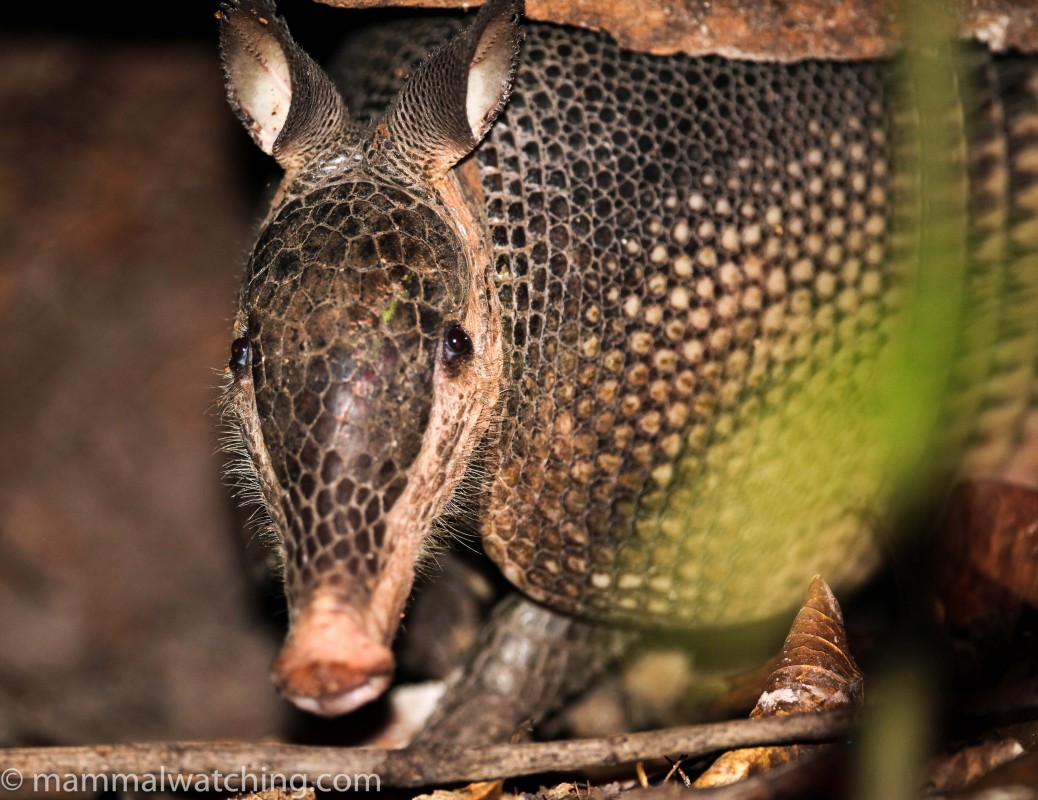
Guyana
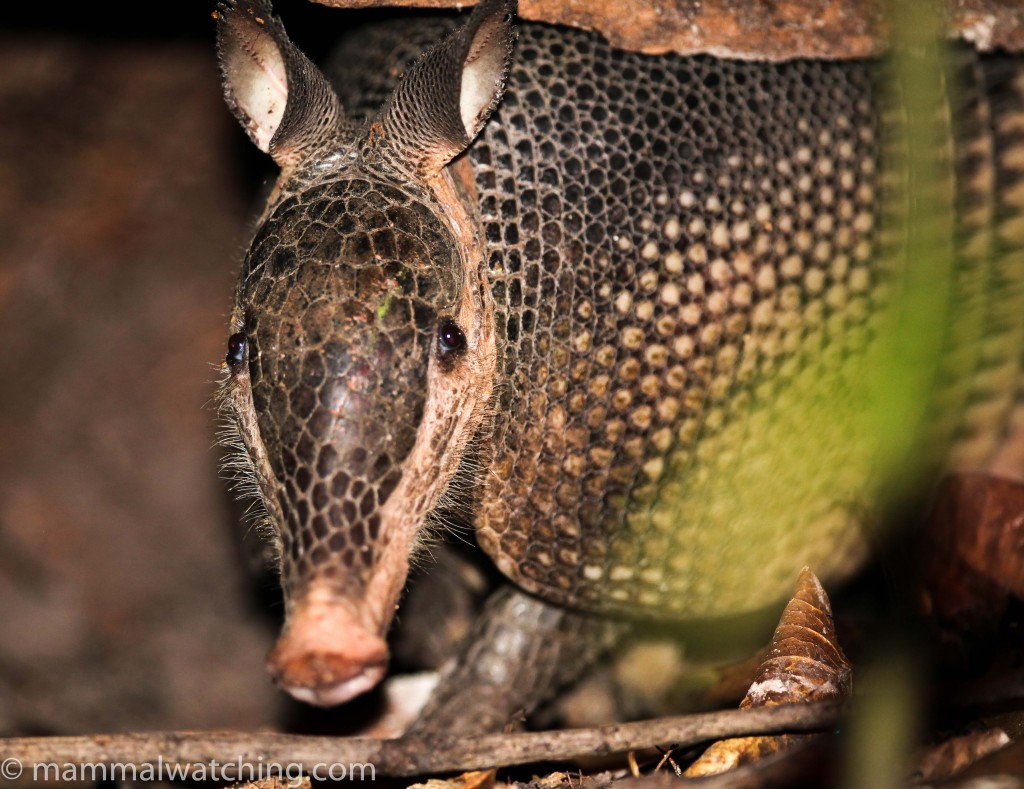
Greater Long-nosed Armadillo, Dasypus kappleri, Rewa
When I started contemplating a trip to Guyana I was puzzled by the absence of trip reports. Why do so few visit this country which, on the face of it, sounds like a mammal watcher’s wet dream? Now that I’m back I’m bewildered. Guyana is just fabulous. It has the most accessible pristine rainforest I’ve ever encountered, abundant wildlife, great guides, good yet inexpensive accommodation and a bunch of near endemic species. But fewer than 3,000 tourists visit the country each year. I’m guessing this will change soon. So get it while its good.
I spent 8 days here in March 2015. I used Wilderness Explorers to make all the arrangements and Joetha and her colleagues did an excellent job though were not used to my focus on mammals which required some negotiation. Gary, from Surama, is also able to arrange some trips into the interior direct.
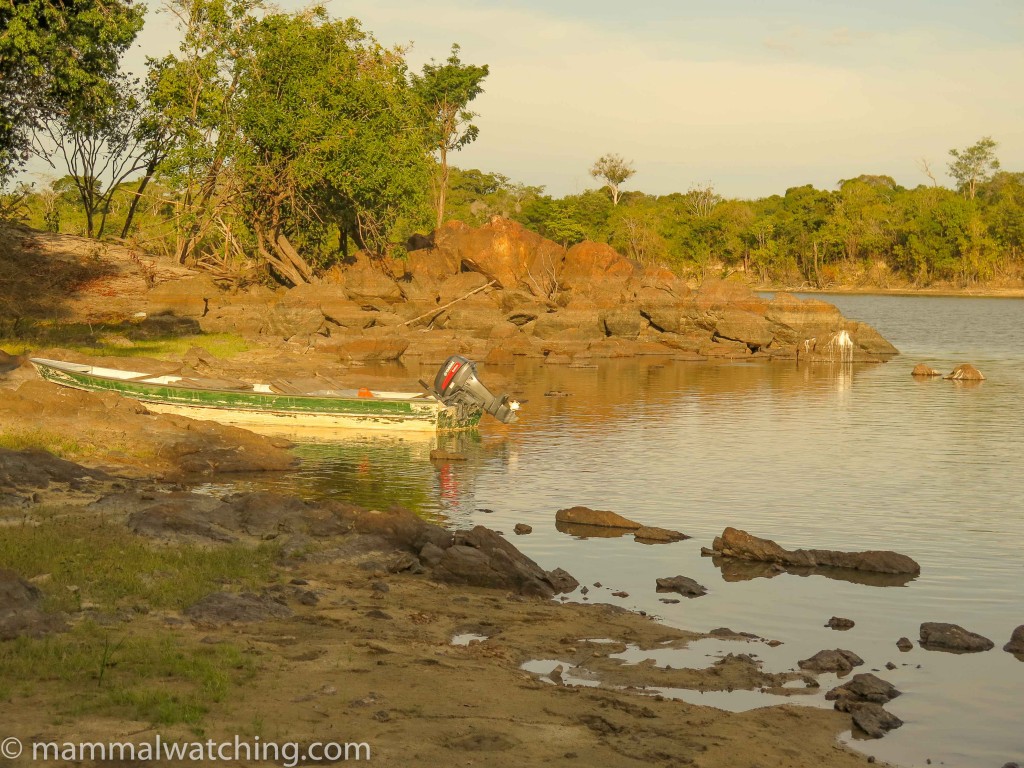
Awarmie, near Rewa
Before you go
I used two trip reports to help me plan the trip: Sjef Oller’s and Ian Lloyd’s. Sjef’s has the most detail and his information remains accurate. Some notes follow on the various lodges but I planned the trip primarily around seeing the six near endemic Guyanan primates which of course influenced my choice of lodges. On the basis of Ian’s report – and a gut feeling that it would be good – I decided to spend 4 nights at Rewa, which proved to be a great decision. I spent the other 4 days in Atta and Surama Lodges in the Iwokrama Forest, both of which I recommend.
March was the end of the dry season. The river was low – unusually low – which limited our movements a little but the mammal watching was good. But it is probably pretty good all year, other than in the very height of the wet season.
Packing
Most naturalists start their trip with a flight on a Cessna from Georgetown to Annai, a small settlement on the edge of Iwokrama Forest. I got dire warnings about the 20lb baggage allowance on the flight, which I thought covered both cabin and hold bags. Given my camera and telephoto lens weigh 10lbs alone I was concerned!
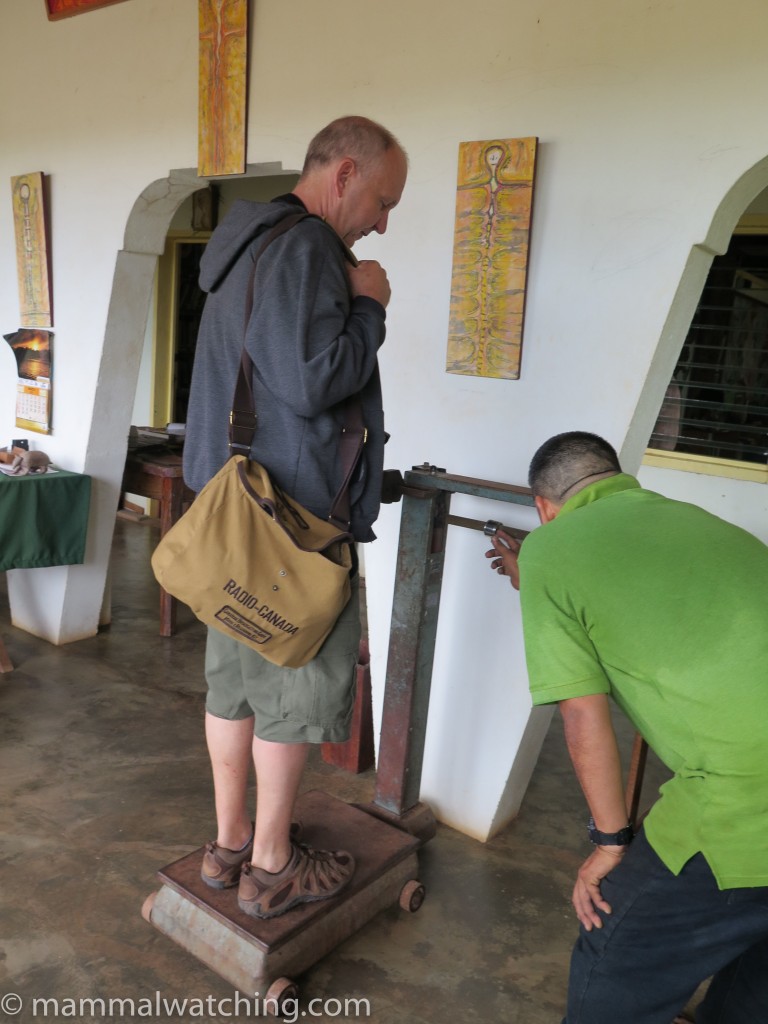
Check in at Annai. Message to my children: no the scales did not say “one at a time please”.
However, I discovered at the airport that you can carry a small bag onto the plane. This is weighed as a part of your body weight (yes you have to stand on the airport scales) but it doesn’t count towards your baggage allowance. It is also usually possible to pay a small fee to check a bit more weight, but this is not guaranteed. Had I understood all this I would have packed more than three teeshirts.
As I’d expected, most of the lodges have the Emmons Neotropical Rainforest Mammals field guide. So I just packed Fiona Reid’s guide to the mammals of Central America and Southeast Mexico. A thorough list of potential mammals from the Smithsonian is here and another – for Iwokrama Forest – is here.
Lodges
I stayed at three places.
Rewa Lodge
Rewa is a community run ecolodge, 2 to 4 hours by motor boat from Annai. Paradise. This really is community run – by the Macushi tribe – and it deserves support for their intentions alone. But it also has fabulous mammal viewing. The lodge is simple but comfortable, and uber flexible. We were the only tourists staying and had the run of the place and the river. Camping trips upriver are available and highly recommended.
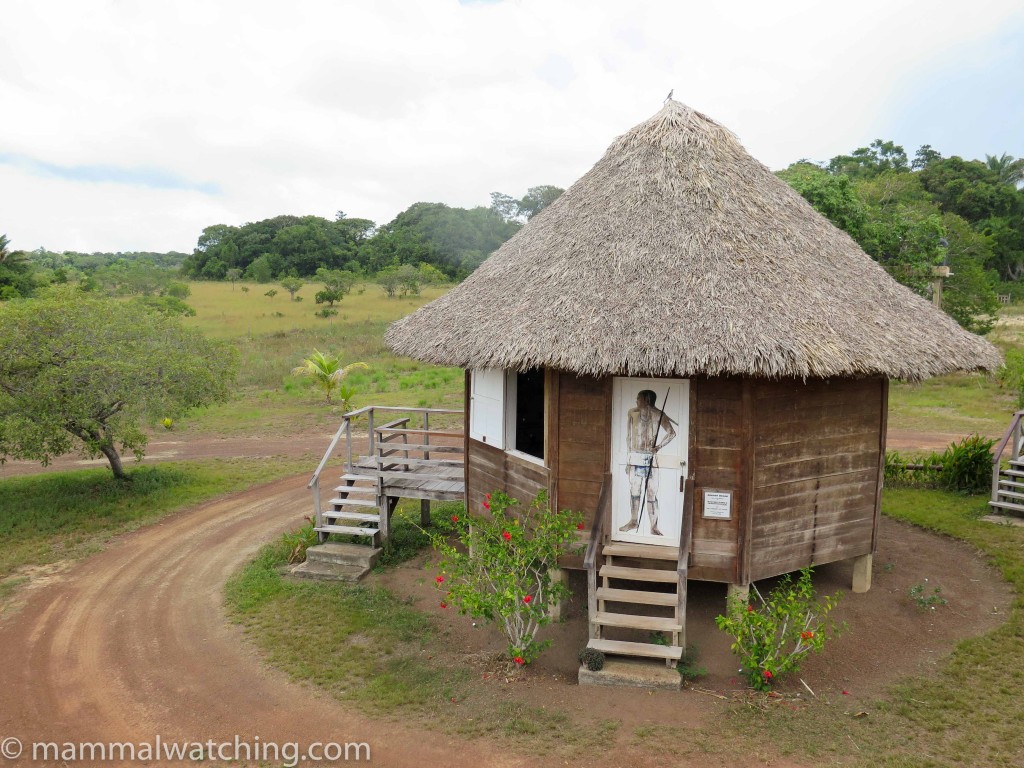
Surama Ecolodge
Surama Lodge
Surama, just outside Iwokrama Forest, is another community run project which was has – rightly – become something of an inspiration to Amerindians in Guyana and beyond. Our guide Gary was a fabulous guy to talk to. Simple, comfortable accommodation, which Jackie and her friendly staff run very well. Lots of nice mammals too in the area – Gary had seen a Bush Dog the month before I was there – though by this point I’d seen most everything I was looking for so slowed down a little during my stay here.
Atta Lodge
Atta, in the Iwokrama Forest, is in a prime location and boasts the Iwokrama Canopy Walkway on its grounds. The food was the best of the trip and once again we were the only tourists staying. Our guide was very keen too and tried hard to find a bunch of things. The place lacked some of the enthusiastic management which we enjoyed so much in Surama and Rewa though.
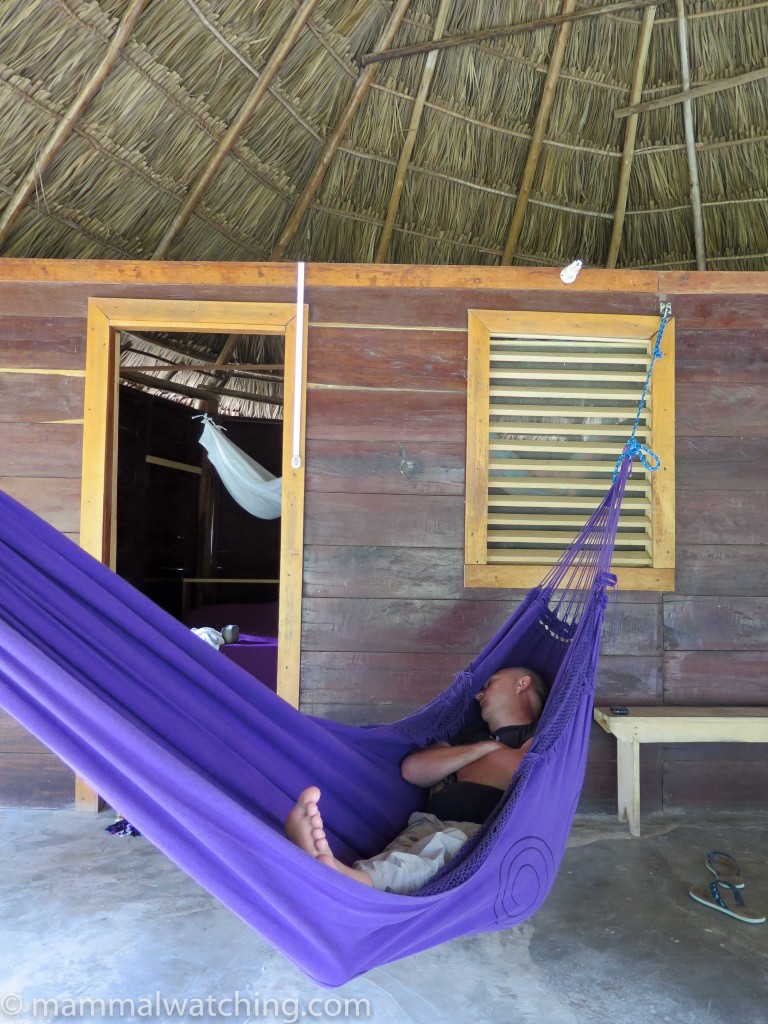
Stressing out at Rewa
I considered – but didn’t stay at – three lodges:
Rockview Lodge – apparently the most comfortable place to stay, and it doubles as the Annai airport so we had breakfast here when we arrived and a coffee when we were leaving. They have a pool which would have been a great luxury elsewhere. It is probably less mammally than the other lodges near Iwokrama but White-faced Sakis, Anteaters and other good stuff are around.
Iwokrama River Lodge – I was tempted to stay here but didn’t have time to visit more than 2 lodges in Iwokrama forest. So, on the basis of Sjef’s report especially, I decided to pass on this place.
Karanambo Lodge – is well known and probably a must if you want to see some of the savannah species (which I wasn’t really chasing). It also seems a great spot for Tayra. Ian Lloyd saw Tayra here and I met people who had just come from the lodge and had seen them throughout the day feeding on mangoes. Had I realised it was less than a two hour drive to get there from Surama I would have taken a day trip.
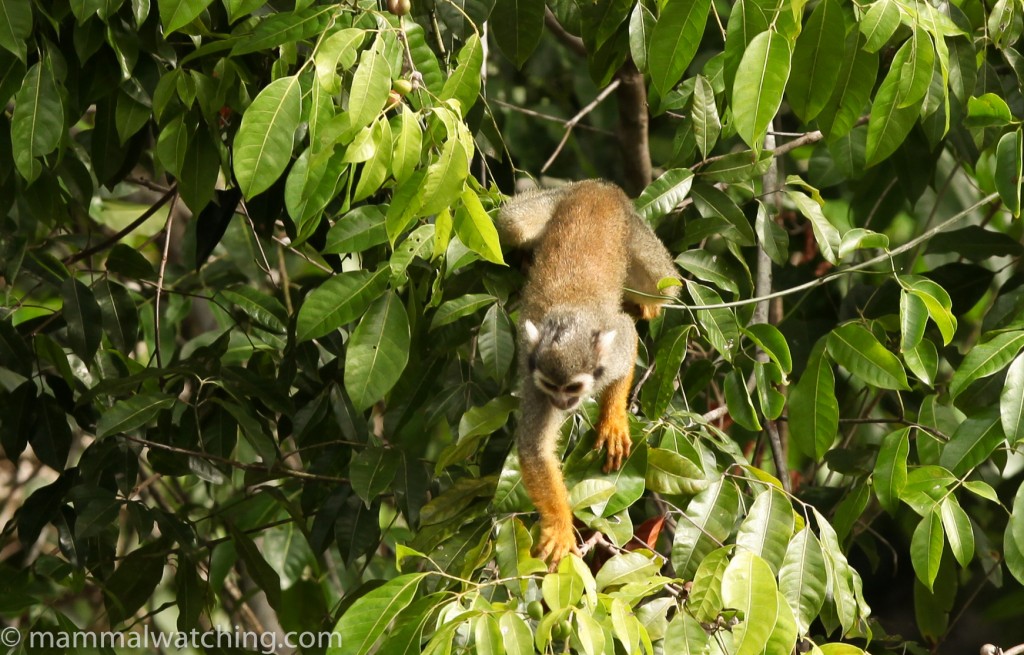
Guianan Squirrel Monkey, Saimiri sciureus
Friday 20 March
The 20 March was – the weatherman claimed – New York’s first day of spring. New York’s weather had a different plan and by lunchtime a blizzard, courtesy of winter storm Ultima, was in full force. So Amber and I were lucky to get out of JFK on schedule for the six hour evening flight to Georgetown. We arrived at 1.30 a.m. and were in bed in our small hotel on the outskirts of the Georgetown by 3 a.m. Quite why the main airport is over an hour’s drive from the capital remains something of a mystery.
Saturday 21 March
I was up again three hours later as we had to be at tiny Ogle airport, in downtown Georgetown, in plenty of time to catch the 8.30 a.m. Cessna flight to Annai in the middle of Guyana.
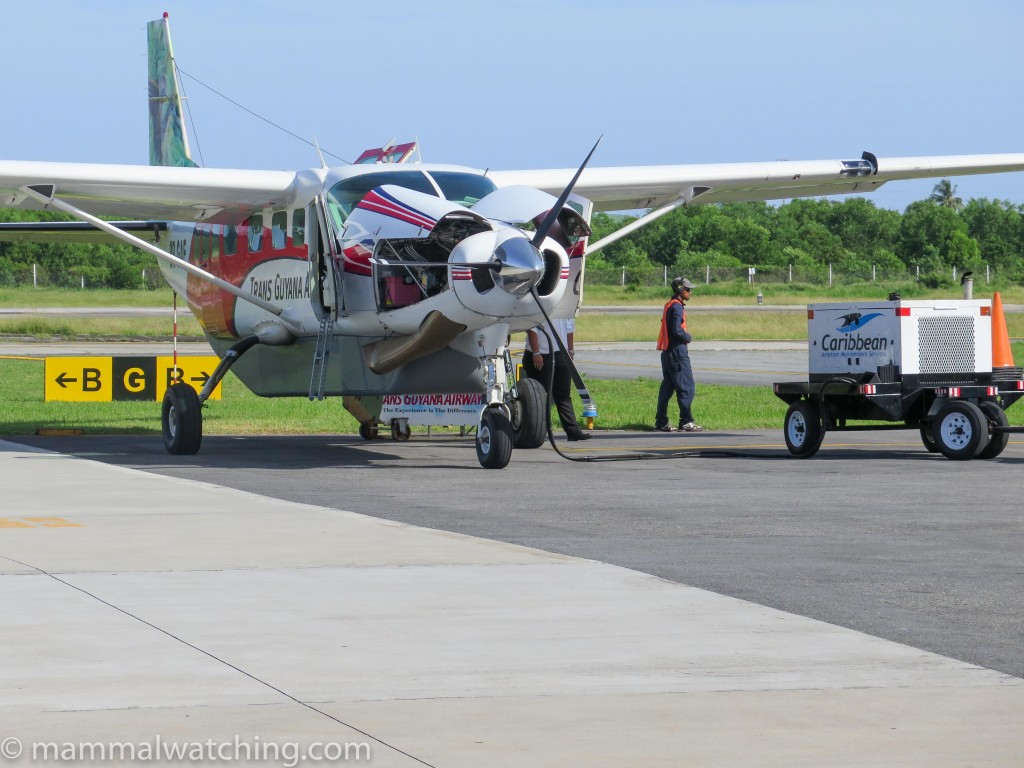
Trans Guyana Airways
I was concerned about the baggage allowance (see the notes above in “before you go”) but the airline seemed quite flexible and didn’t raise an eyebrow when we checked 55lbs between the two of us. This comprised 25lbs of camera gear, another 15lbs of flashlights and field guides and very little else. I bet I could have packed a few small mammal traps after all. Oh well.
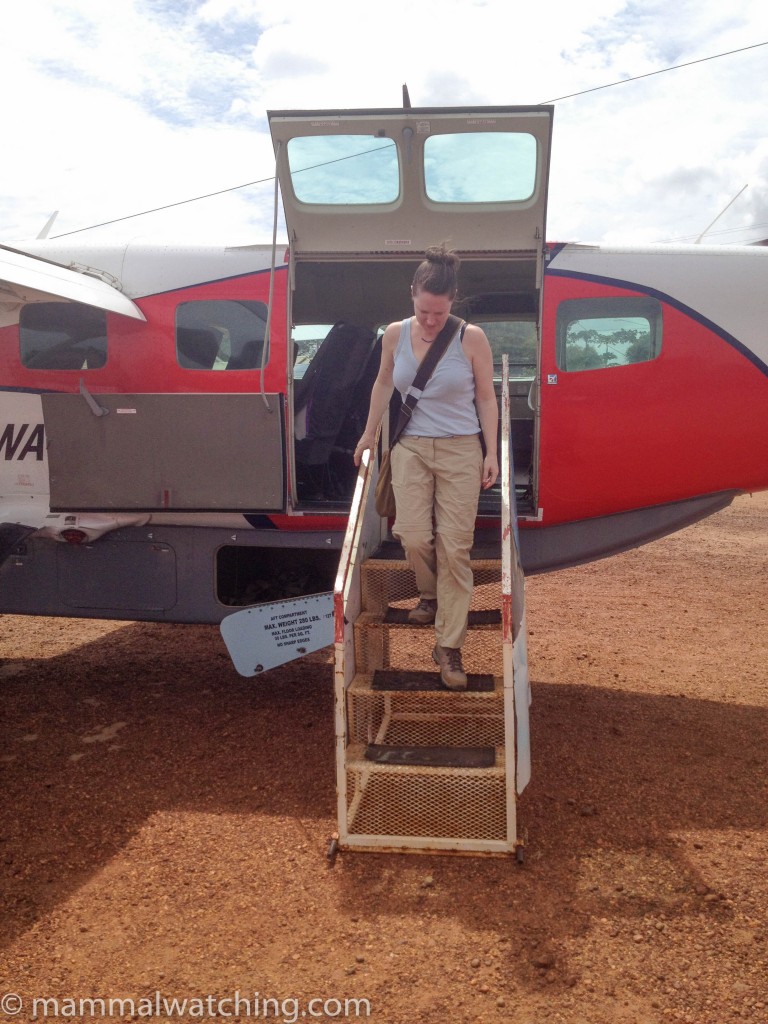
Trans Guyana Amber
We had a quick breakfast at Rockview lodge, which doubles as Annai airport (I use the term loosely), before transferring to a motorboat for the trip up the Rupununi River to the Rewa Ecolodge.
We didn’t see a great deal of wildlife on the way – not surprising as we were on the water from noon to 3 p.m. – though there were many Spectacled and Black Caimans, some of which were surprisingly large. Our guide – Cain – stopped to show us a procession of Long-nosed Bats roosting under a fallen tree.
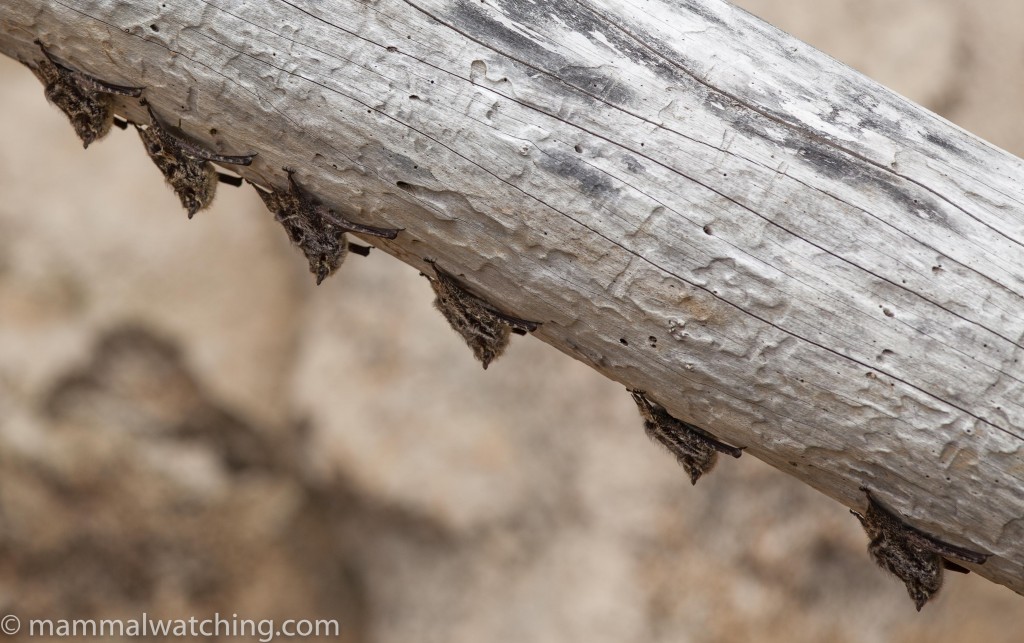
Proboscis Bat, Rhynchonycteris naso
Just before we got to Rewa Lodge we saw a family of four Giant Otters. I’d only seen this species a couple of times before. Always great to see and they are really quite common along this stretch of river.
Be warned. The boat has no shade and though it was overcast we should have known better and worn more than teeshirts. I rarely sunburn but Amber’s Canadian skin has seen much less than its fair share of UV light over the years. She slowly – and unknowingly – fried.
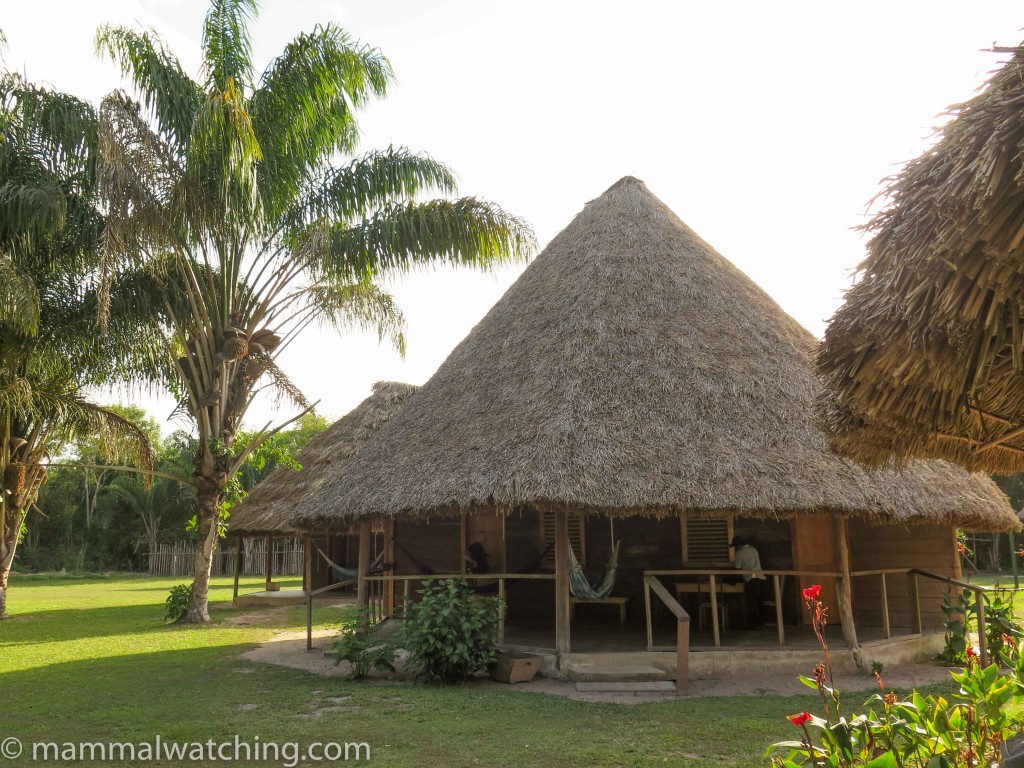
Rewa Lodge
Rewa Lodge was set up by the Amerindian community a few years ago. It is simple accommodation on the edge of a huge tract of pristine forest. You’d need to travel for several weeks upriver from the lodge before finding another settlement. A few hundred tourists stay each year and we were the only ones during our stay.
My key target here was the Golden-handed – or Midas – Tamarin, which seems rarely, if ever, seen at the other two lodges on our itinerary. Cain said he saw them from time to time but was rather vague as to how often.
A first walk around the forest behind the lodge at 4 p.m. was unproductive for me, though Cain spotted a couple of Red-rumped Agoutis. A Giant Otter cruised past the lodge at 5 p.m. and we took a dusk trip upriver which soon came alive with bats, some Greater Fishing Bats and what I think were Lesser Fishing Bats too, along with many other species I’m sure. Well after sunset we had great views of a Paca, though the great views translated to terrible pictures. I hadn’t packed my flash as I hadn’t anticipated we’d be coming home at night.
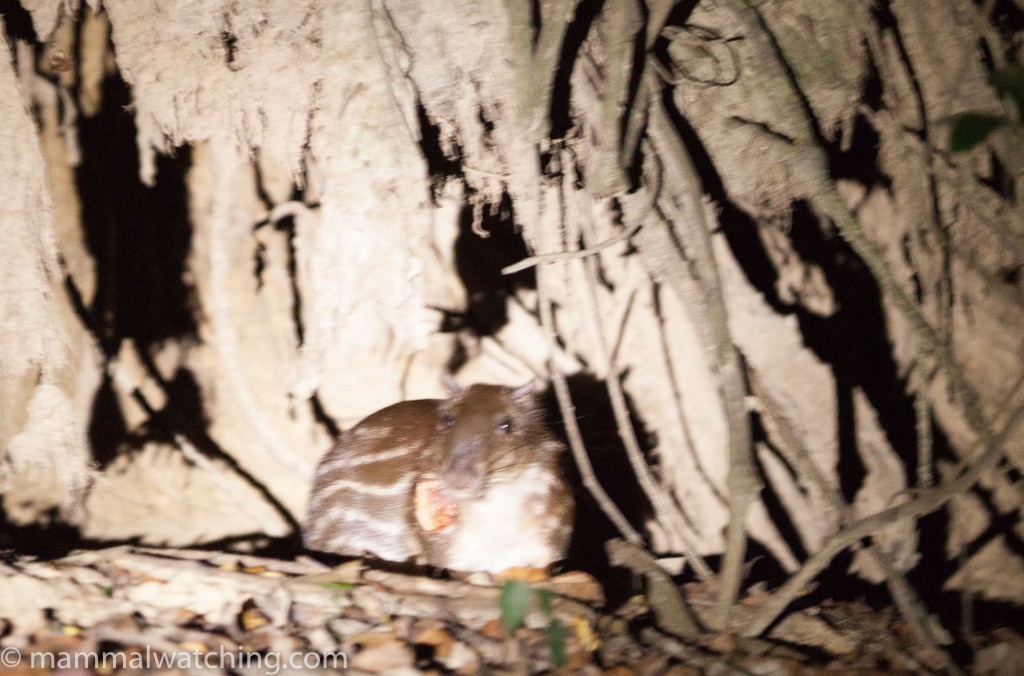
Blurry Paca, Cuniculus paca
A brief stroll around the lodge after dinner produced a Black-eared Opossum in the palm trees by the trash heap.
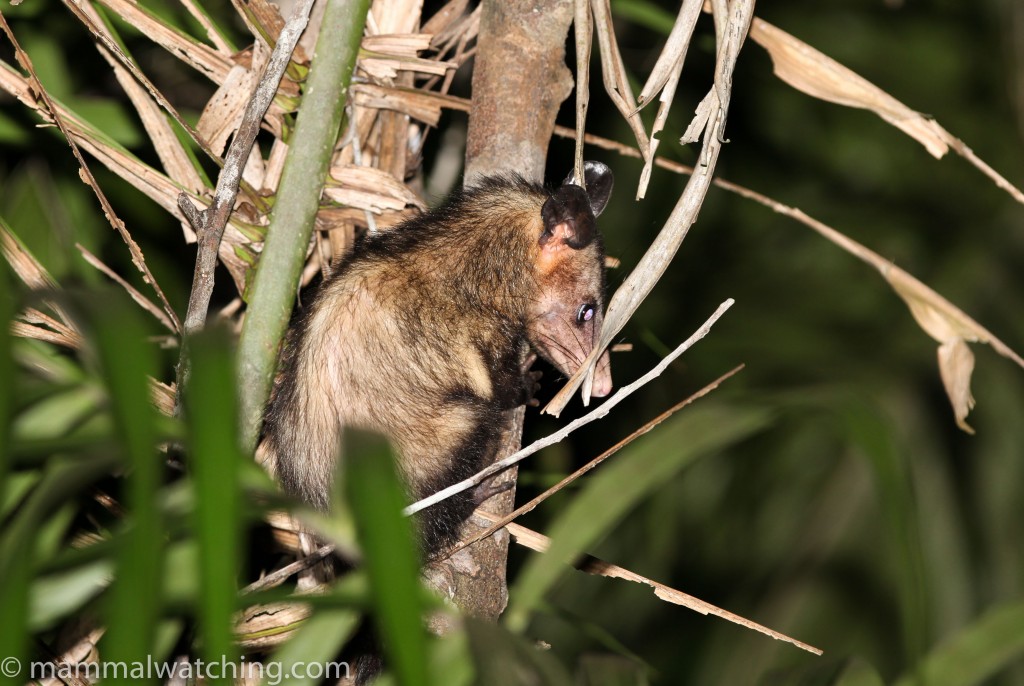
Black-eared Opossum, Didelphis marsupialis
Sunday 22 March
At dawn the trees in front of the lodge were alive with the sound of Guianan Squirrels, which I tried hard to turn into Yellow-throated Squirrels … but couldn’t. A few distant Guianan Howlers were calling too.
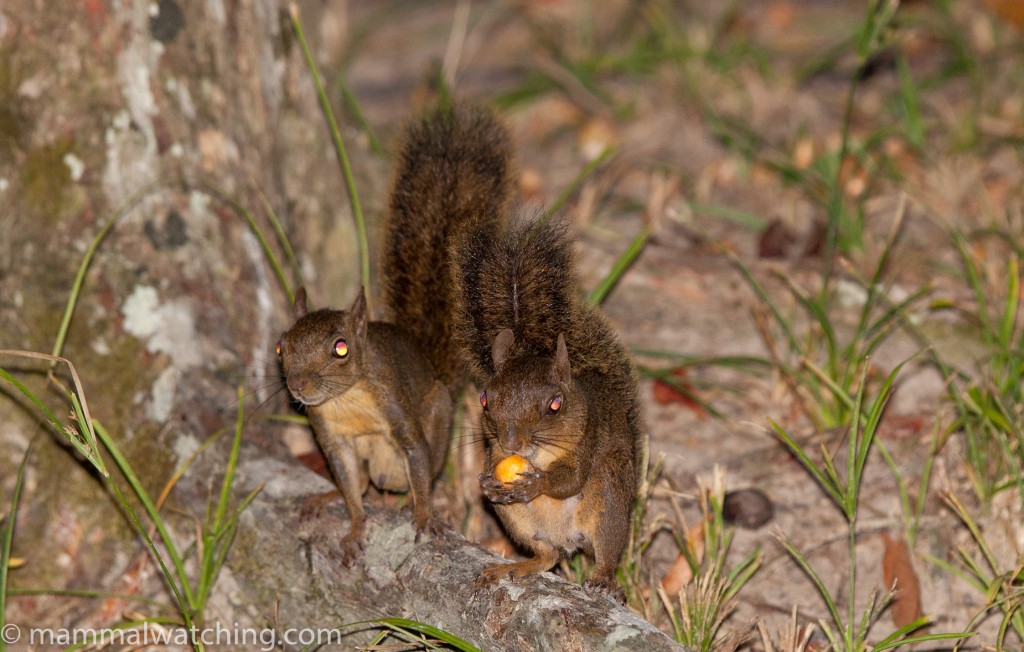
Guinean Squirrels, Sciurus aestuans
We set off at 7 a.m. for a 2.5 hour walk through the scrubby secondary forest behind Rewa Village in search of the Golden-handed Tamarins.
Cain spotted another Red-rumped Agouti and heard what he thought were Guyana Weeper Capuchins, but they were too far off the trail to be seen. Close by we saw a troop of Brown Capuchins. But still no Tamarins.
Back at the lodge we sat down for a coffee when Edna, one of the housekeepers, ran over: Tamarins behind the cabins! I dashed over to get brief views of a few animals moving – and whistling – their way through the trees.
Rewa offers guests the chance to camp upriver at a number of locations. And so we’d planned to spend the next couple of nights doing just that. River-burst camp, on an oxbow lake, is the usual spot and sounds lovely. But the water levels in the river were so low that boating was extremely slow: the usual journey time of two hours might take four or more (in fact Cain later decided it would have taken eight hours).
We decided instead to camp at the much closer “Banana Sucker” site, which still took three hours to reach. No matter though, the river upstream of Rewa is gorgeous. It is pristine primary forest with no sign of humanity. And it seems the wildlife – at least since Rewa has been established – is also doing well.
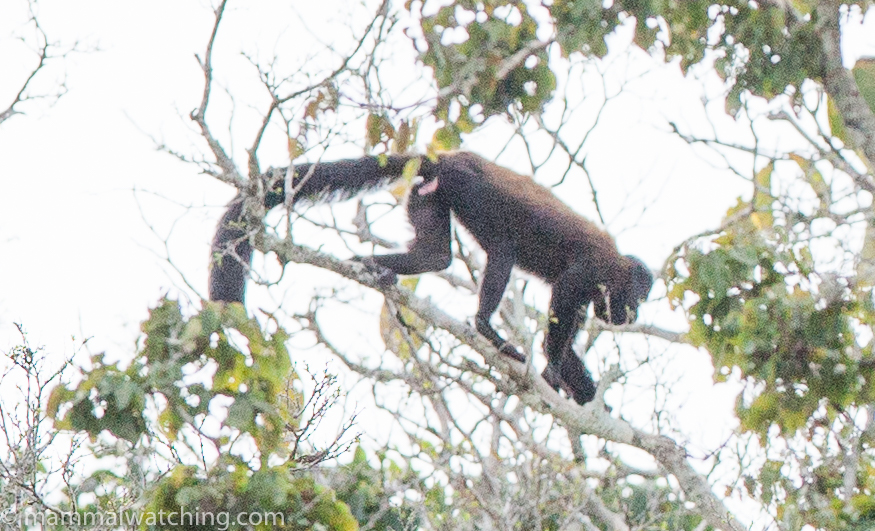
Guianan Bearded Saki, Chiropotes sagulatus
The first mammals of the ride were some Squirrel Monkeys. Close behind them were some Guianan Bearded Sakis, my second lifer of the day, though photography up into the canopy was a challenge.
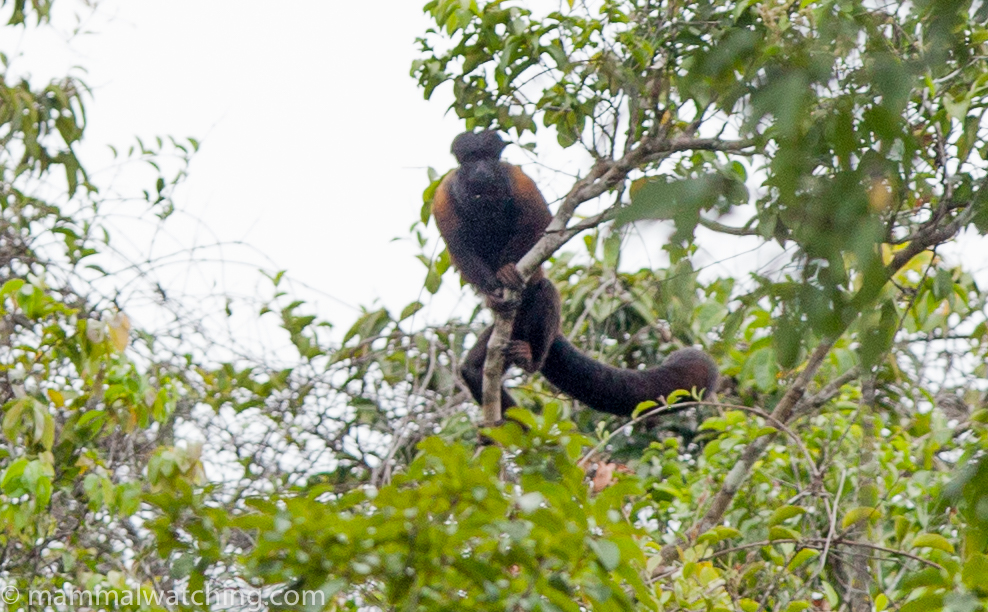
Guianan Bearded Saki, Chiropotes sagulatus
Further down the river Cain spotted more Bearded Sakis and, while we were watching those, we heard Brown Capuchins across the river. I turned to look for them and saw instead several Guianan Red Howlers, the third new primate of the day.
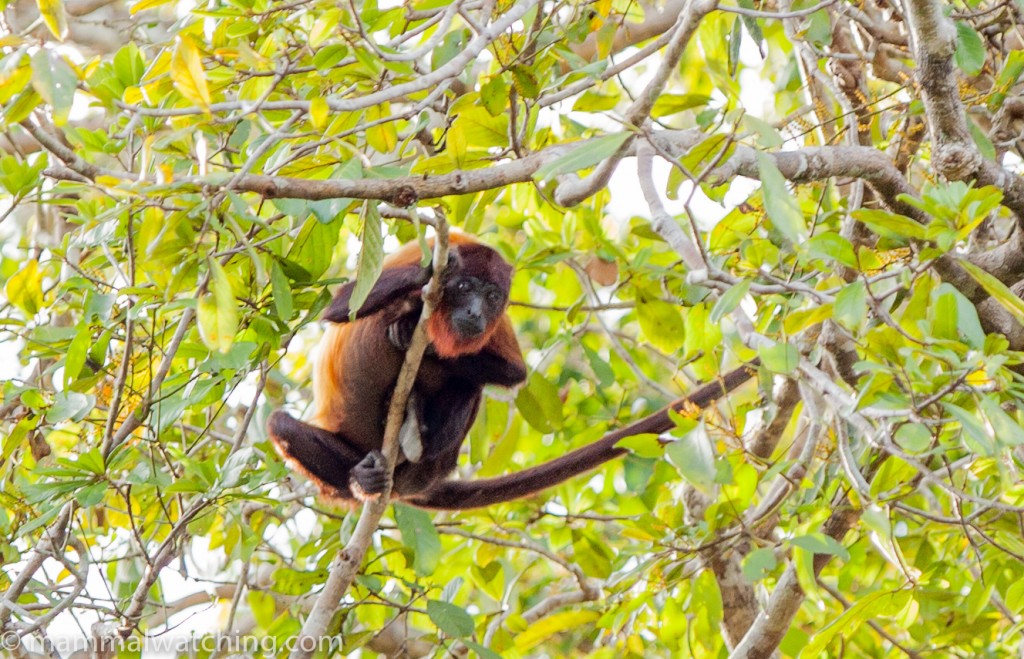
Guyanan Red Howler Monkey, Alouatta macconnelli
Later on we saw more Giant Otters.
Three more Rewa staff were waiting for us at the lovely campsite they’d just built. Not only had they put up a dining and cooking area, but also showers and a bush toilet. Seldom have I camped in such luxurious solitude. No one seemed to know why the place was called “Banana Sucker Camp”. I didn’t see any bananas.
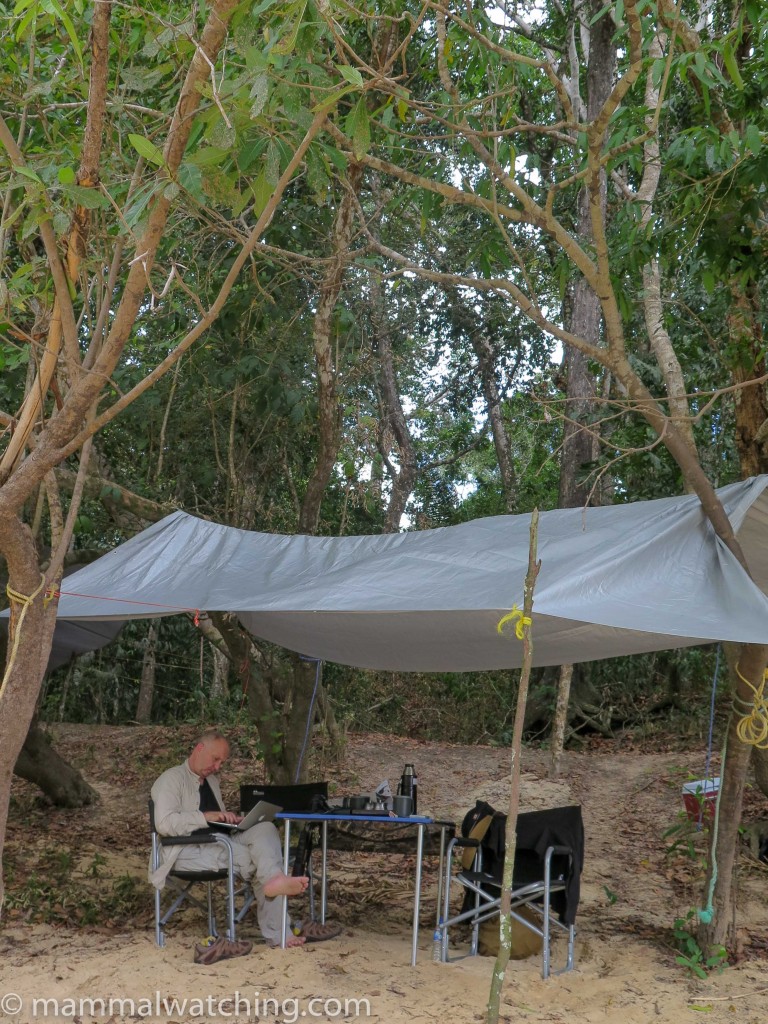
Banana Sucker Camp
I didn’t spend much time that night looking for animals along the trail behind camp – a trail that leads eventually to a fishing pond – but during a short walk I did spot a Paca, while a large bat flitting around was most probably a Woolly False Vampire.
I slept like a log in my hammock. Amber confirmed her fear that hammocks and third-degree sunburned shoulders do not mix well. So she didn’t sleep much. Upside, she did hear a number of interesting noises through the night, though probably missed many more that were drowned out by my snoring. Mental note: next time I am in a hammock I should request a 50 yard no sleep exclusion zone. All I heard were the howlers.
Monday 23 March
We got started a little later than I’d hoped: the weather was overcast so we – or rather I – didn’t wake til gone six. By seven we were heading further upriver for a morning cruise.
We saw two more groups of Bearded Sakis (apparently the commonest primate along this stretch of river). Just great to have such prolonged looks at saki monkeys which are usually so elusive. One troop was travelling with Golden-handed Tamarins. On the way back down the river we saw more howlers.
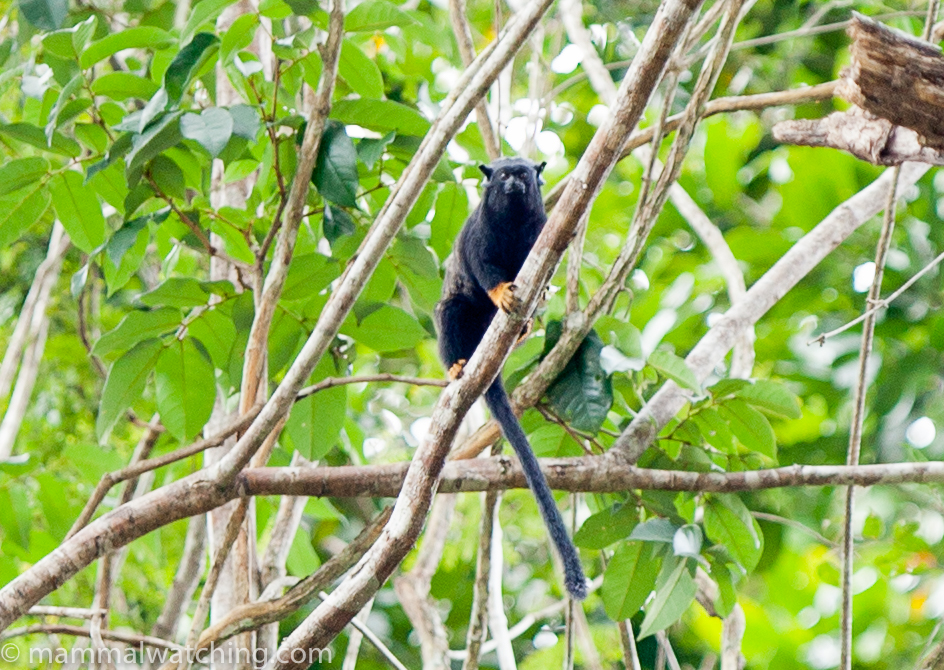
Golden-handed Tamarin, Rewa
After setting up some mistnets for batting in the evening we headed a little way upriver and took a late afternoon walk through the forest. It wasn’t long until we heard a troop of monkeys. Cain called “Brown Capuchin” but the first one I got my bins on was a Guyanan Weeper – or Wedge-capped – Capuchin. Our sixth species of primate at Rewa (remember there are only eight species of primate in all Guiana). Another lifer for me. There were more Brown Capuchins back near the boat.
I’d set up three nets: two in the forest and one on the beach in front of camp. The two nets in the forest were unproductive – just a single Greater White-lined Bat (Saccopteryx bilineata) after dusk. But the net by the river caught a bunch of species, nearly all of which were new for me.
First, a Southern Stripe-headed Round-eared Bat.
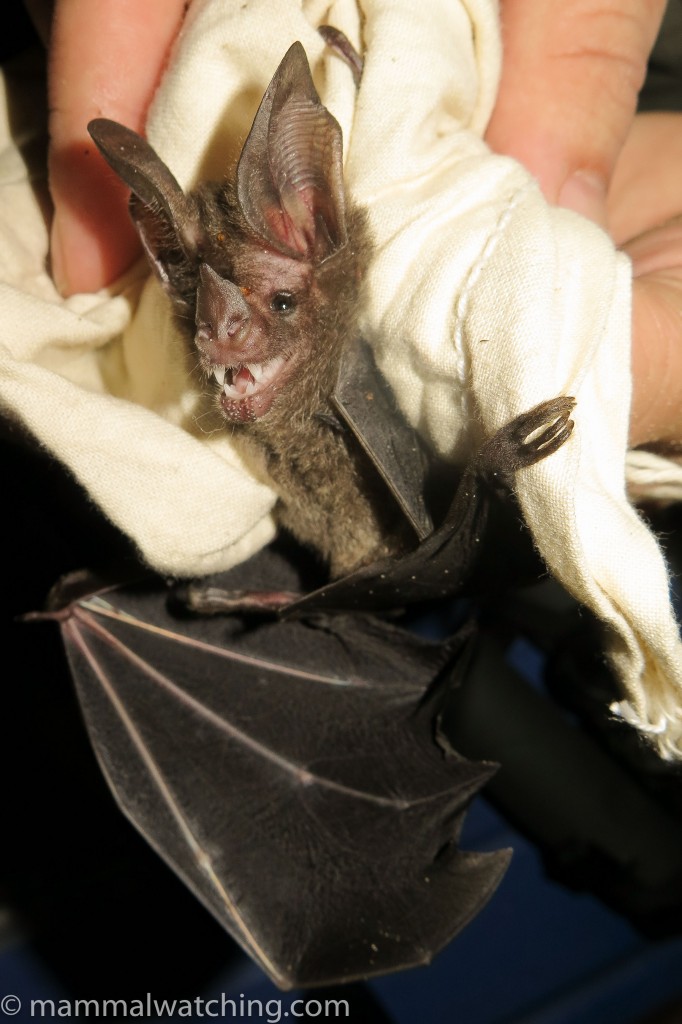
Southern Stripe-headed Round-eared Bat, Tonatia maresi
Then some Lesser Spear-nosed Bats.
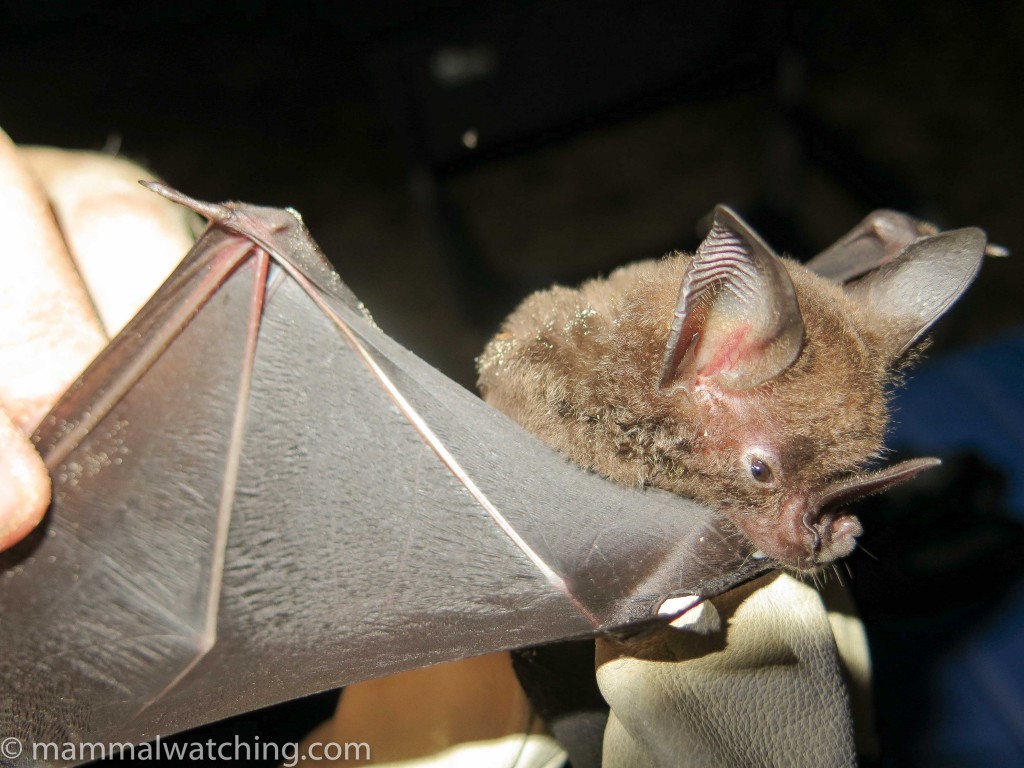
Lesser Spear-nosed Bat, Phyllostomus elongatus
And that I caught a strange little bat that Fiona Reid later identified as the little known Homez’s Big-eared Bat. As of 2020 this species has been lumped with M. minuta but may be resurrected as M. hypoleuca one day.
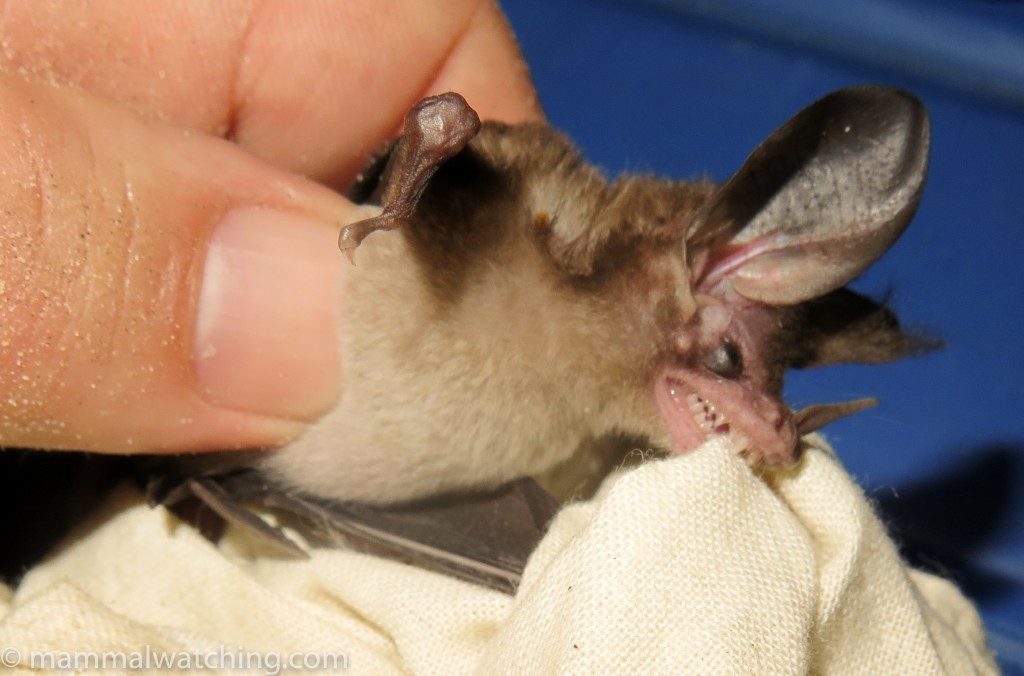
Tiny Big-eared Bat, Micronycteris (homezi) microtis
The next one was a lifer too, the distinctive Dwarf Little Fruit Bat.
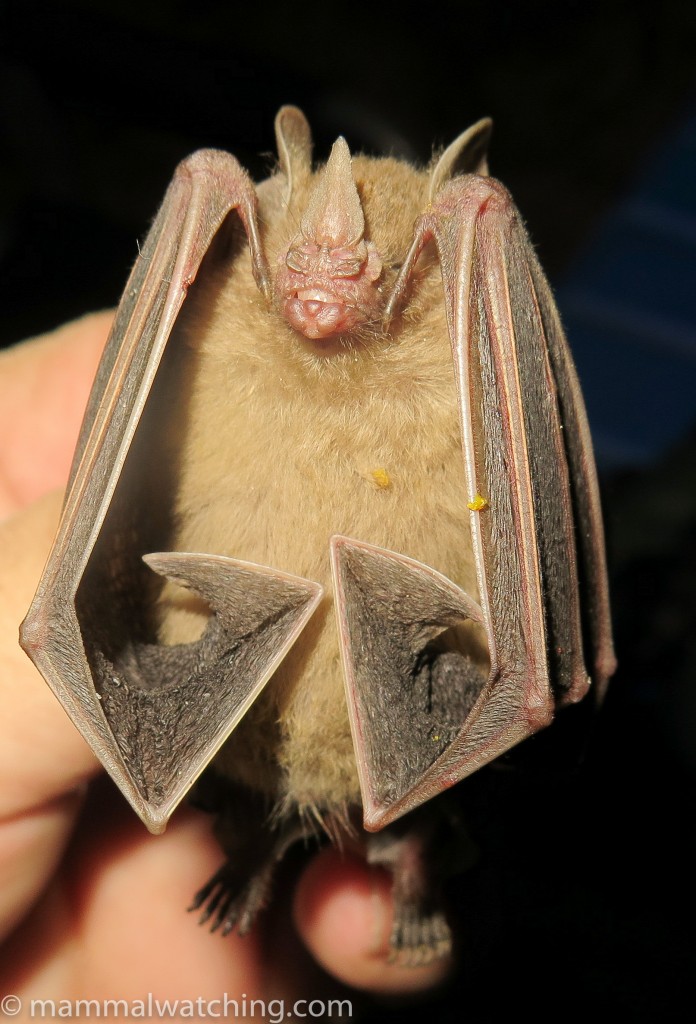
Dwarf Little Fruit Bat, Rhinophylla pumilio
The last species of the evening was also a lifer, the little Gervais’ Fruit-eating Bat.
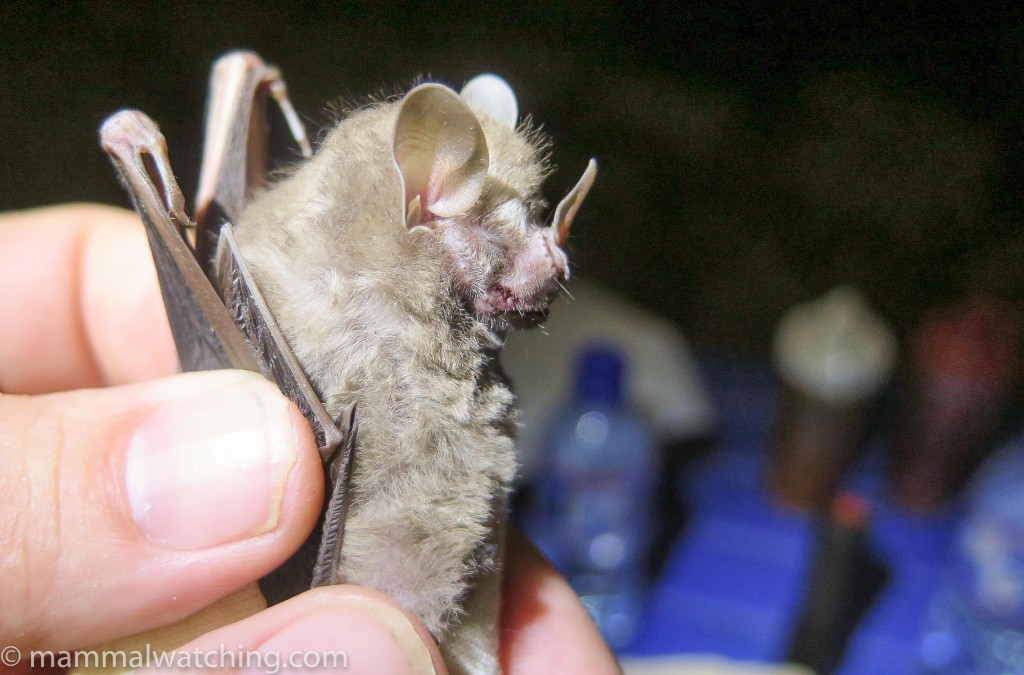
Gervais’ Fruit-eating Bat, Artibeus cinereus
A great night batting. But it wasn’t over. We closed the nets at 8 p.m. and took a walk into the forest. After 10 minutes Cain heard a rustling and we caught a glimpse of a large Armadillo bolting into a hollow log. The next 10 minutes were a mammalwatcher’s delight. Part high drama, part slapstick comedy.
We could hear the Armadillo in the log. So Cain dispatched Amber and me to one end while he stood at the other and tried to persuade the animal to leave. Its footsteps – inside the log – grew closer to us, along with a sort of grunting noise that reminded me of a fat man forcing down the last forkful of a 36oz steak. But still the animal wouldn’t exit. So Cain, ever resourceful, chopped down a palm tree and used the trunk as a pipe-cleaner. As the log was a good 30 foot long this was no mean feat. It did the trick and out popped the head of a very large Greater Long-nosed Armadillo.
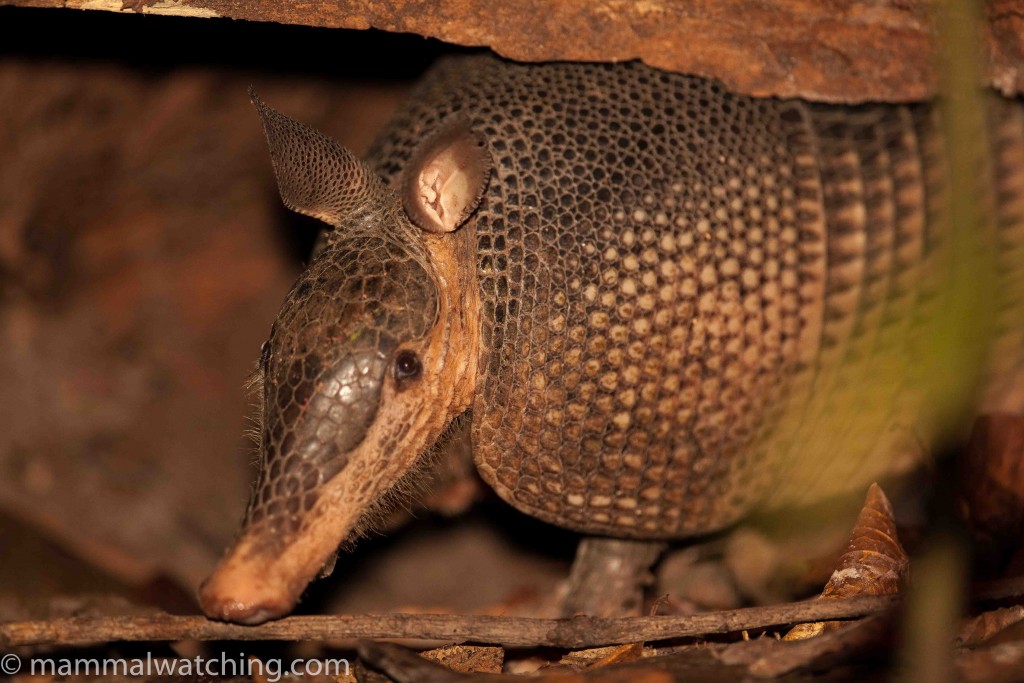
Greater Long-nosed Armadillo, Dasypus kappleri
The animal hung around for a few photos before charging into the forest – and straight through a large dead log – at impressive speed. Just a fabulous sighting of a really cool animal. I’ve wanted to see this species for a long time but don’t recall anyone reporting it on a trip report (though Tobi Lundqvist went and saw one on pretty much the same day as I did while he was in Ecuador).
Cain was adamant that the species was a “Giant Armadillo” and, when I read my field guide, I saw that in many areas the local name for this species is Giant Armadillo. Indeed a small Giant Armadillo and this beast would not have been dissimilar in size.
We walked on for another 15 minutes and on the way back spotted another Long-nosed Armadillo which looked a little smaller to me. It might conceivably have been the same animal but I suspect it was different. Rewa, it seems, is a good spot for Dasypus kappleri!
Tuesday 24th
We left camp at 7 a.m. for the three hour boat trip back to Rewa Lodge. Half way along we stopped for Brown Capuchins, then some Squirrel Monkeys closely followed by a Harpy Eagle, one of the few birds in the world I wanted to see almost as much as some of the mammals. It was a smaller male. Not as epic as one of the enormous 12kg females, but it perched on the edge of the river, just 15 yards from us, for a good 10 minutes. Wow.
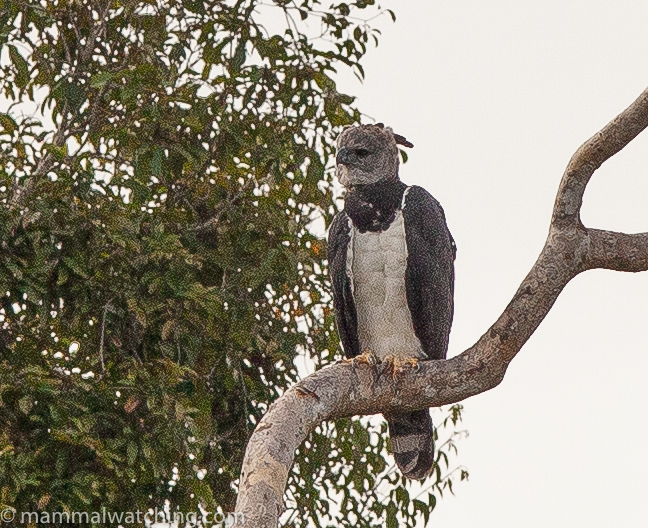
Harpy Eagle
The Harpy Eagle eventually noticed the Squirrel Monkeys we’d just been looking at and flew in their unfortunate direction.
Ten minutes later we came across yet another group of Giant Otters. The family of four reluctantly swimming away from us, carrying the piranhas they’d been munching on, but continuously popping up to look back and see – with an expression of hope – if we were still following them.
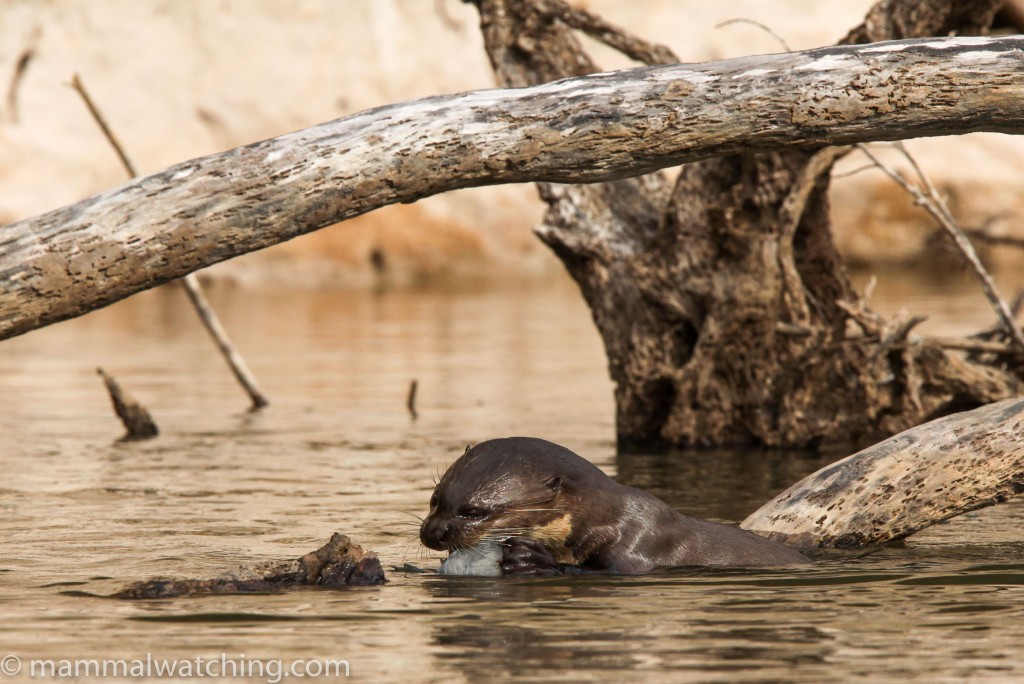
Giant Otter, Pteronura brasiliensis
We rested at camp. In the afternoon Cain and I boated up the main Rupununi River for 30 minutes to an area called Awarmie, a patch of dry forest, next to some fields in the shadow of a hill. This area is often good for Black Spider Monkeys, our goal for the afternoon.
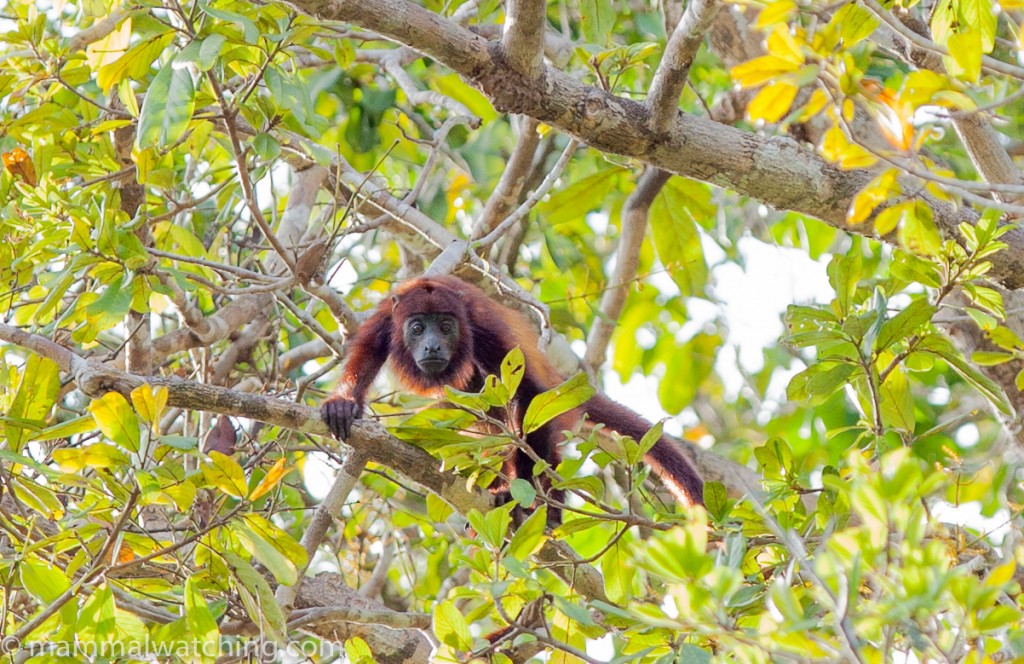
Guyanan Red Howler Monkey, Alouatta macconnelli
We saw one Black Spider Monkey from the river as we were approaching the site, but couldn’t track any down in the forest, perhaps because it was so dry. Cain did spot a couple of Red Howlers though. In 2013 he’d seen Bush Dogs in this patch of forest three or four times. Pretty much the only sightings in the area I heard of.
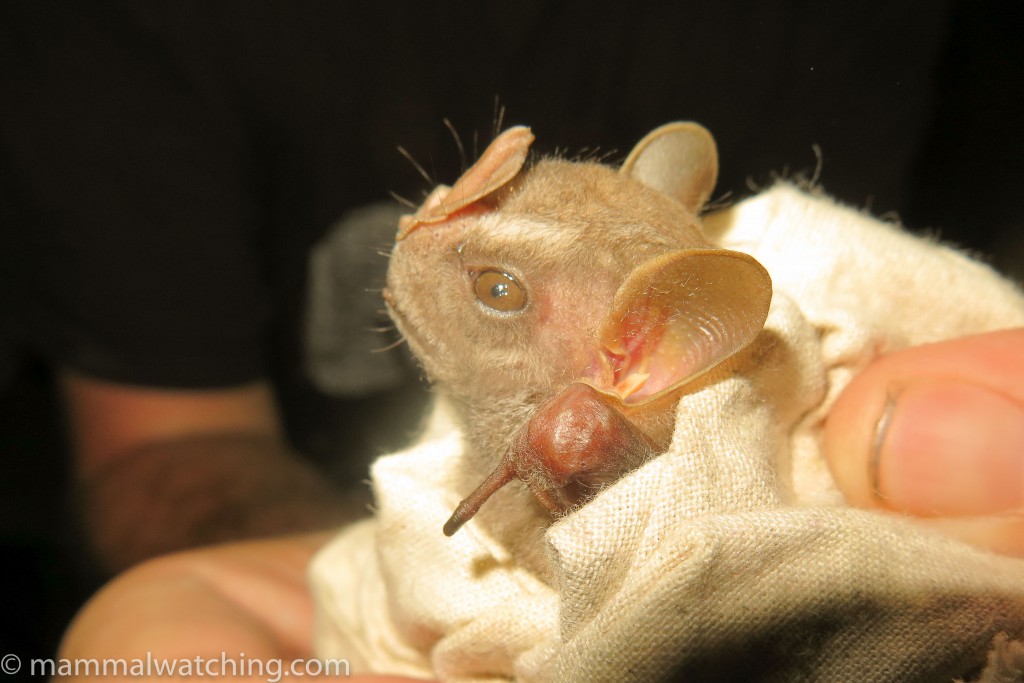
Hairy Big-eyed Bat, Chiroderma villosum
We set a few bat nets up at dusk around the lodge. The first – next to one of the lodge’s fruit trees – caught eight bats in the first three minutes, mainly Hairy Big-eyed Bats.
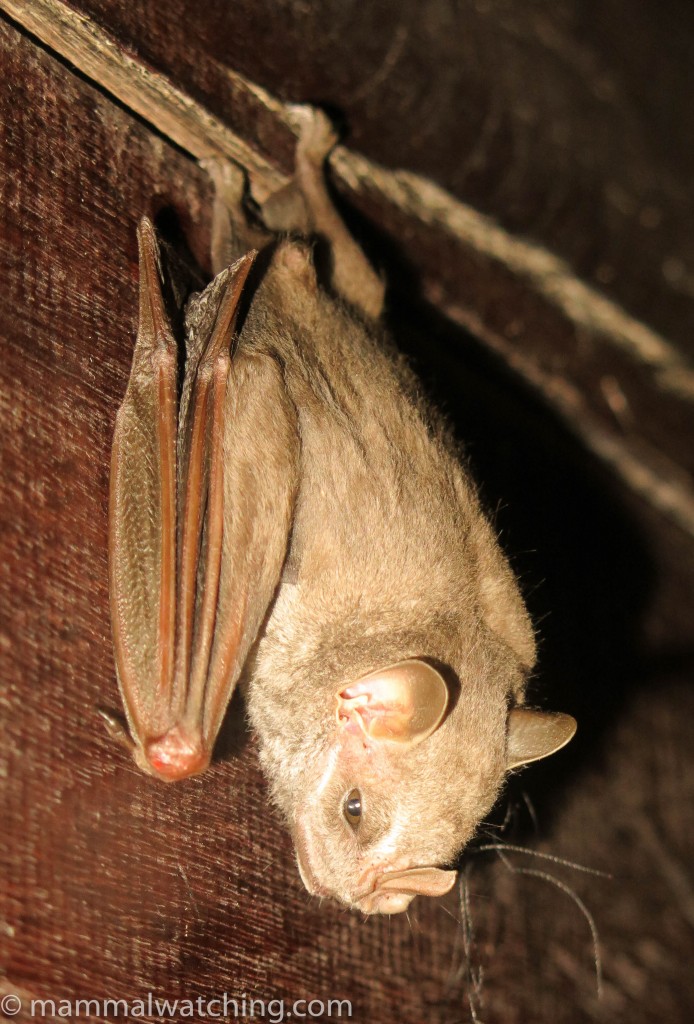
Hairy Big-eyed Bat, Chiroderma villosum
And one Brock’s Yellow-eared Bat, a lifer for me.
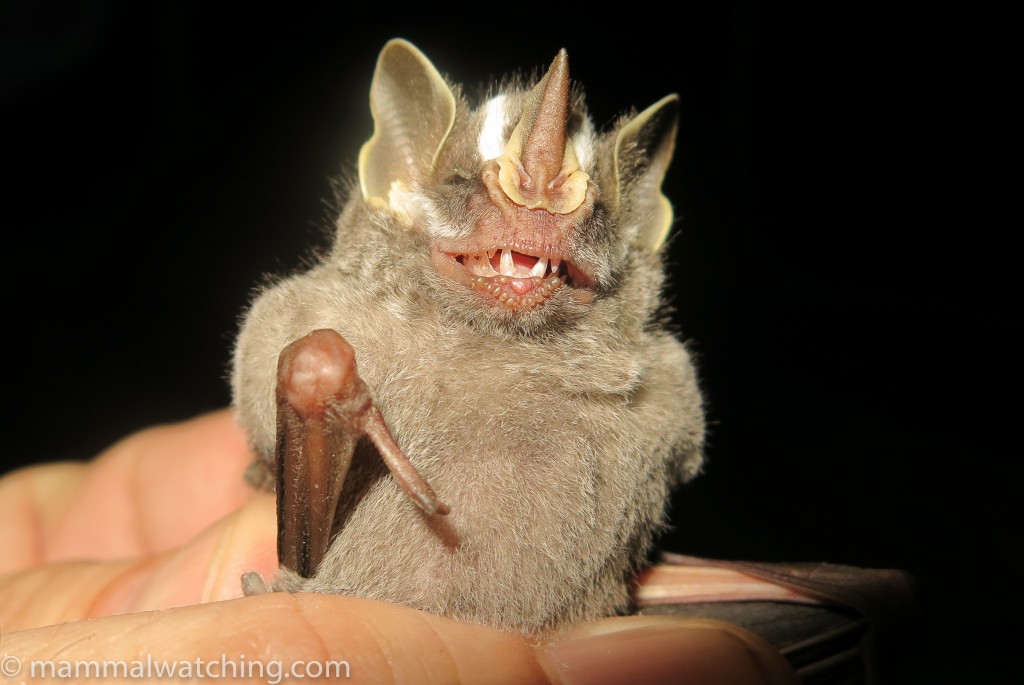
Brock’s Yellow-eared Bat, Vampyressa brocki
Another net along the trail into the forest caught a cloud of Seba’s Short-tailed Bats later in the evening.
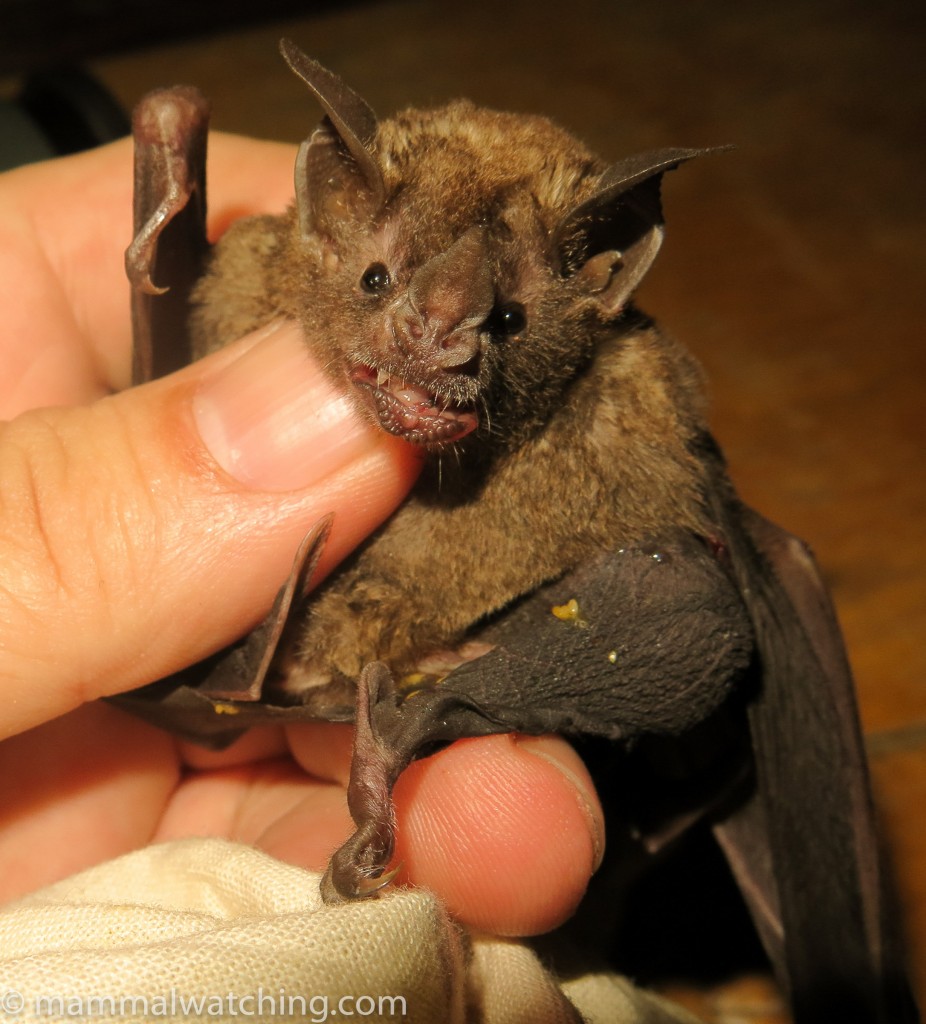
Seba’s Short-tailed Bat, Carollia perspicillata
I woke in the night to hear something raiding the garbage bin in next to the kitchen but couldn’t get a glimpse. Cain agreed that it was most probably a Black-eared Opossum.
Wednesday 25 March
We left at 5.30 a.m. for our transfer back to Kwatamang Landing (near Annai village) and from there to Atta. We saw a few Black Spider Monkeys along the river just after dawn and stopped for breakfast on a sandbank. The Rewa chef’s bready-donuty dish, known as “bake”, had become a big hit.
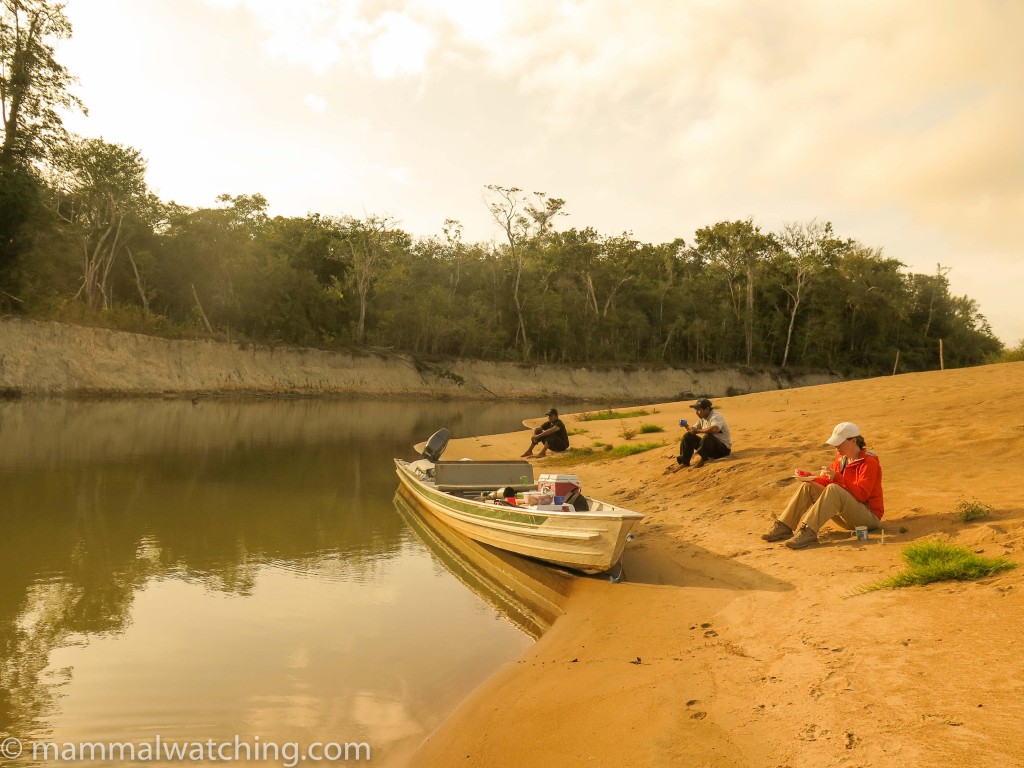
Breakfast on the river
It took 3.5 hours to get to the landing. From there it was just an hour’s drive to Atta Lodge, in the heart of the Iwokrama Forest Complex, where we met John, our guide, along with Dylan, his apprentice. Once again we were the only guests. Extraordinary how few people travel to Guyana.
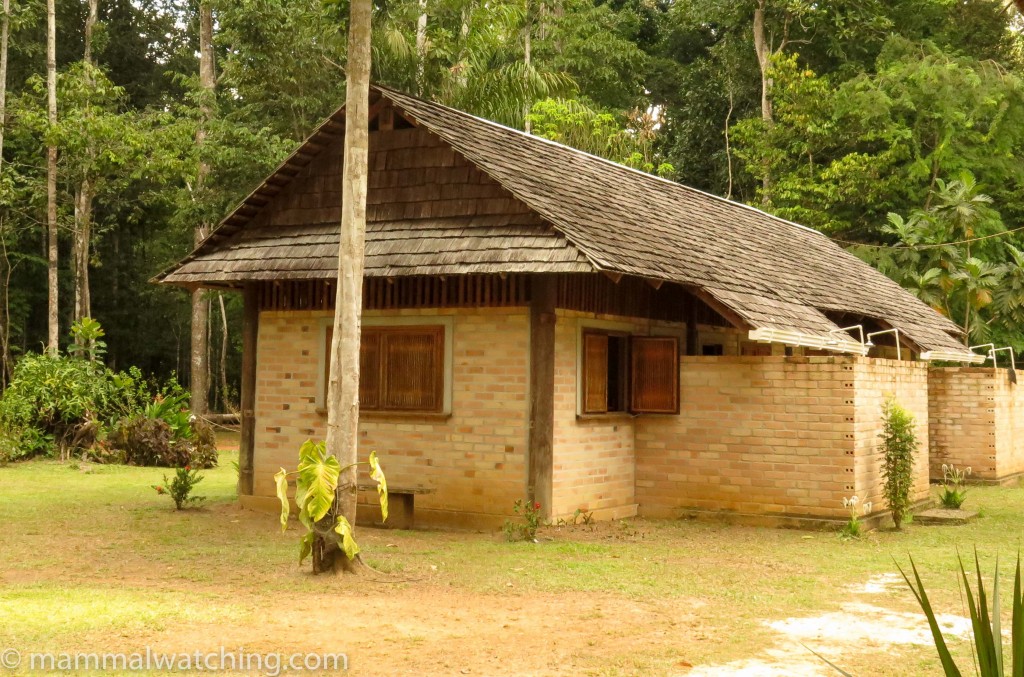
Atta Lodge
The news of Amber’s sunburn preceded us. Most of Guyana now seemed to know she was “allergic to the sun”. Truly a Canadian illness.
When planning the trip I’d figured I would spend my four days in the Iwokrama forest focussed on the primates we’d missed at Rewa. But, as Rewa had been so primate-tastic, we had only the White-faced Sakis left to see. Of course there were other species on my wish list, including the two sloth species (Pale Throated Three-toed Sloth and Linne’s Two-toed Sloth) and the ever elusive Tayra.
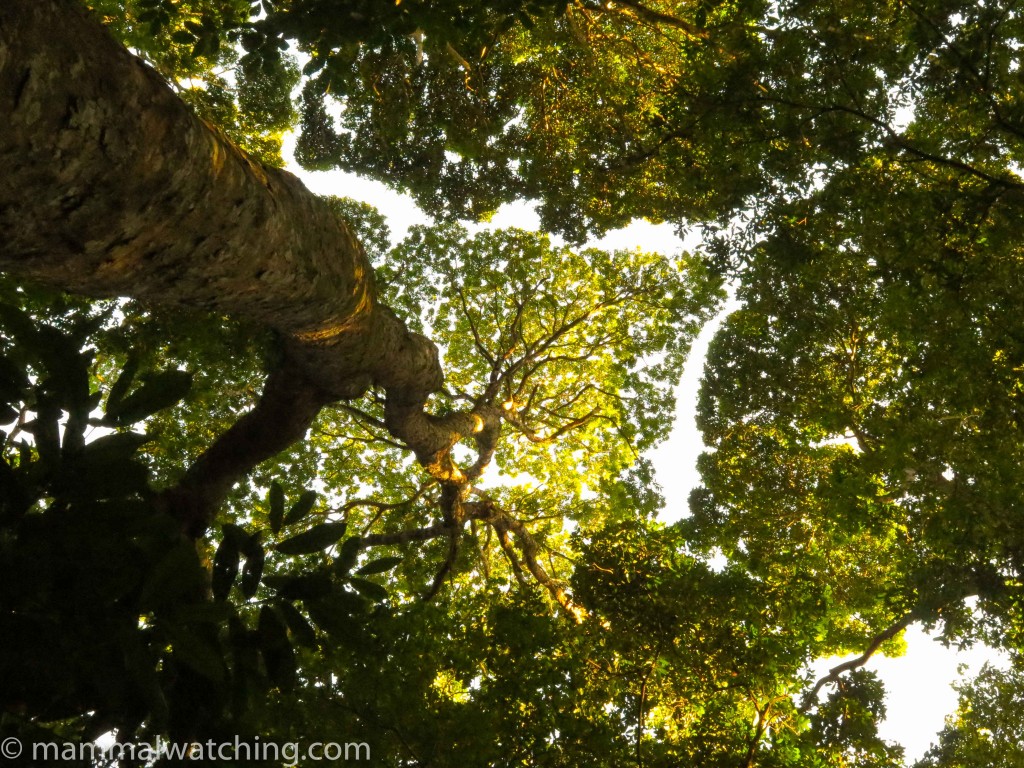
Atta forest
John said that only four species of primates normally occur at Atta: Spider Monkey, Red Howler, Brown Capuchin and White-faced Saki. The Sakis are the rarest although he sees them relatively often. He saw sloths occasionally too, often in the Cecropia trees along the main road and had seen one a week before at the turn off to the lodge.
We took a walk that morning for an hour but saw no mammals. John told me that a smallish opossum had been found living in the kitchen the night before but had been chased away.
Back at the lodge John went on an opossum hunt. A few minutes later he produced a small cardboard box in which an opossum, nursing a bunch of young, had taken up residence. My first Long-furred Woolly Mouse Opossum which put on an unnerving display of teeth and hissing when I went in for a closer look. Though it made no attempt to bite me.
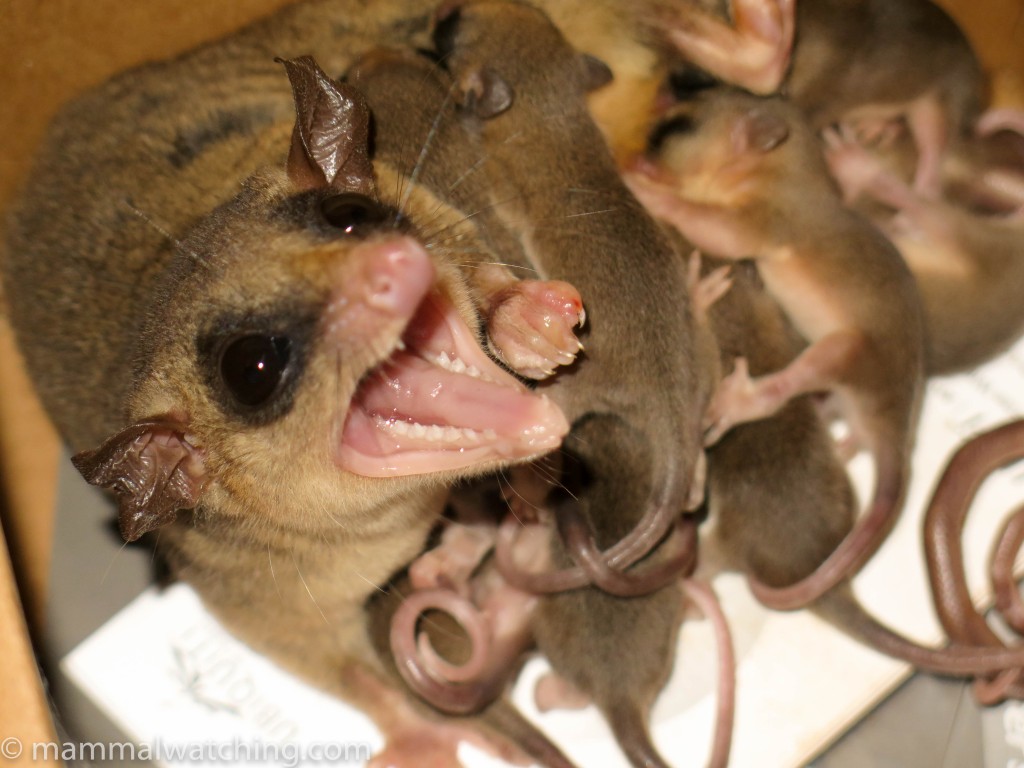
Long-furred Woolly Mouse-Opossum, Micoureus demerarae
After a siesta, in the middle of which Amber spotted a Brown Capuchin in the lodge gardens, we visited the canopy walkway for the late afternoon. The walkway is a 10 minute walk from Atta lodge and comprises an impressive set of five tree platforms joined by suspended walkways 100 feet in the air. A great spot for a sundowner beer but not so great for mammals, at least not that night. Though we heard – but didn’t see – howlers and distant spider monkeys.
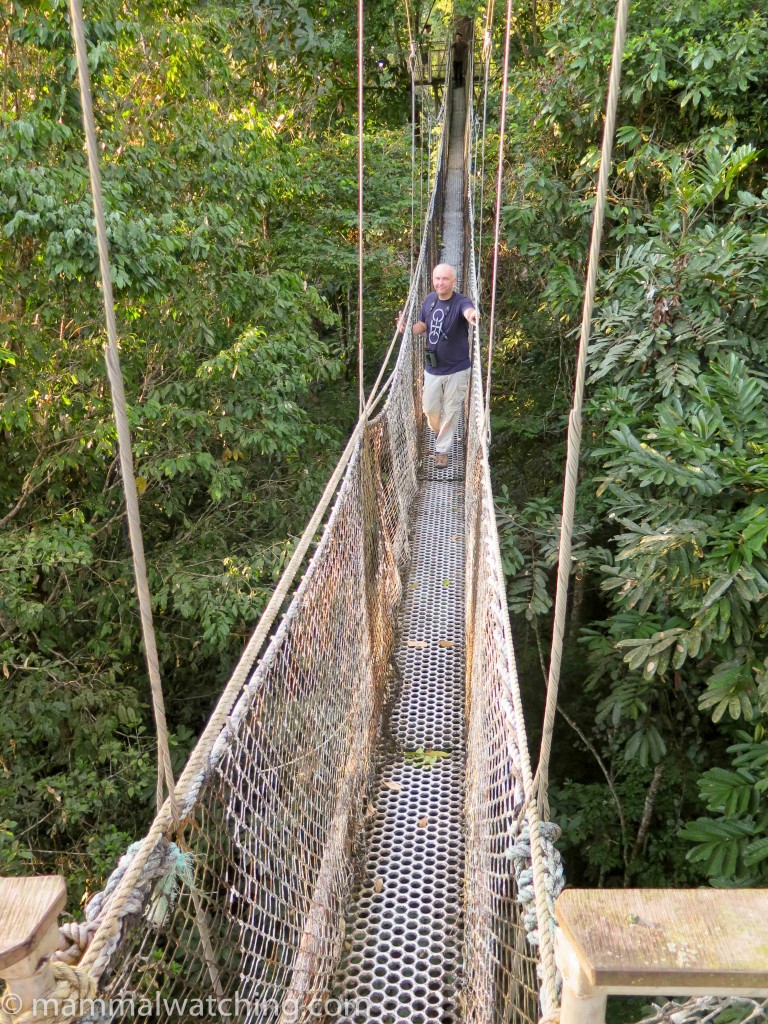
Canopy walkway
Walking back from the canopy walkway after sunset we saw a Red-rumped Agout. Dylan and I walked on along the entrance road with a spotlight for half an hour and saw a Kinkajou about half way along.
Dinner, like lunch (and every meal in Atta) was excellent.
Thursday 26 March
We were up at dawn to try again for the White-faced Sakis. There were no mammals near the canopy walkway but a walk through the forest produced a few Black Spider Monkeys that gave prolonged views. After breakfast we found more spider monkeys along the road, probably from the same troop.
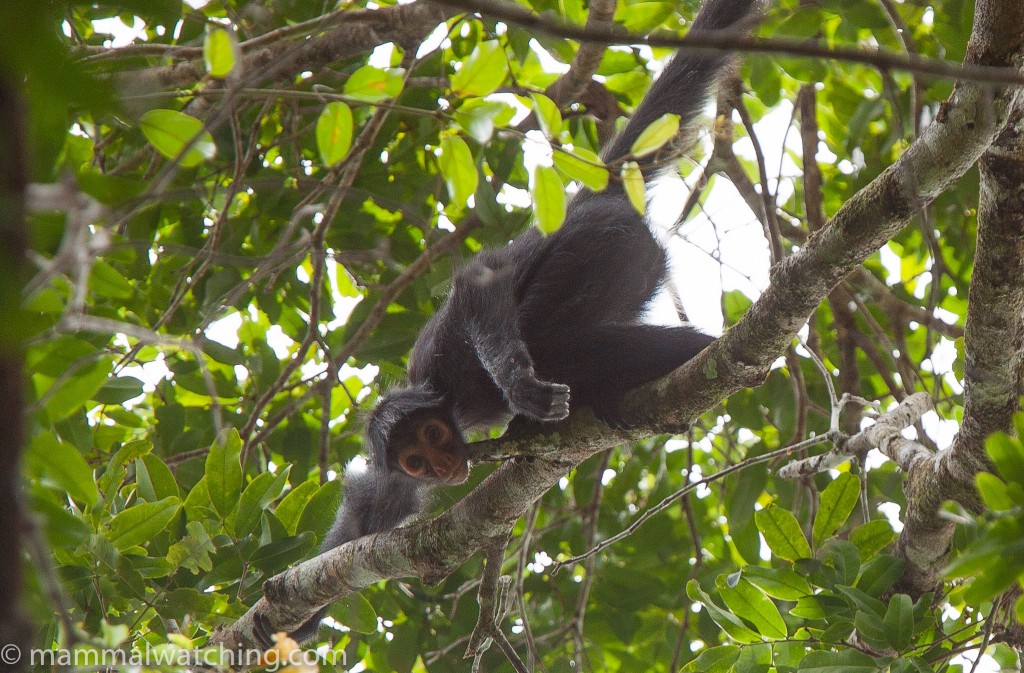
Black Spider Monkey, Ateles paniscus
The mouse opossum had left her cardboard box but she was soon relocated in an empty drawer in the dining room. After lunch and a siesta, John and I set up a couple of mist nets near the lodge.
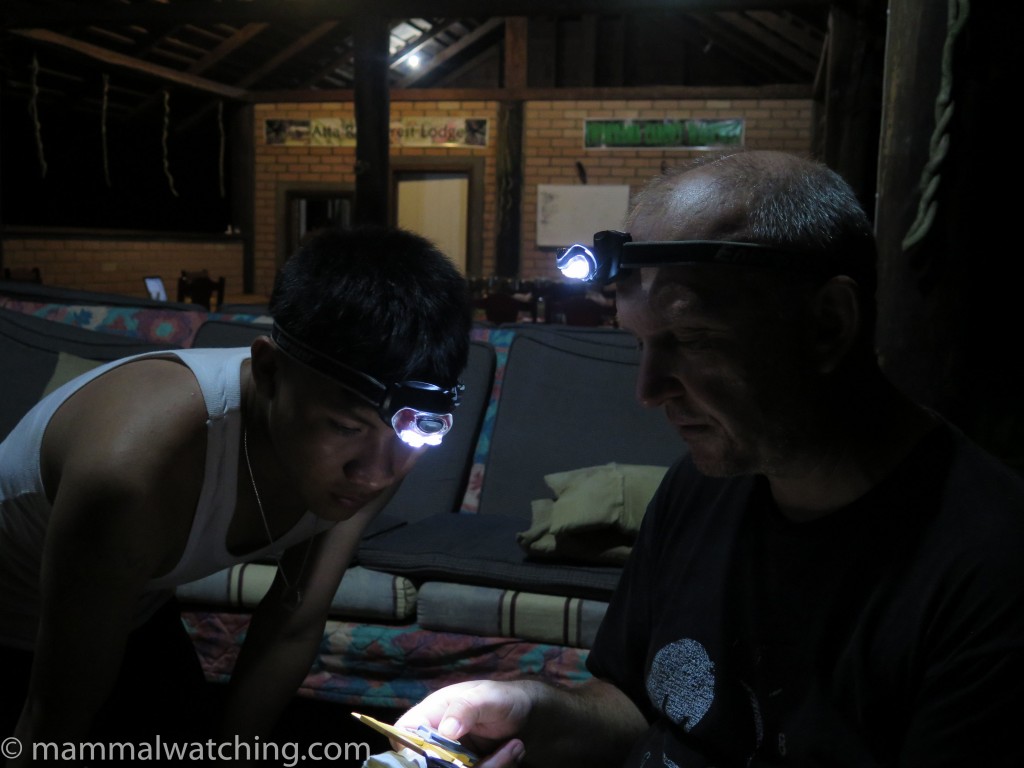
Bat catching
Batting that night was slow but the three animals we caught were all different and the first two were new for me starting with this Silky Short-tailed Bat.
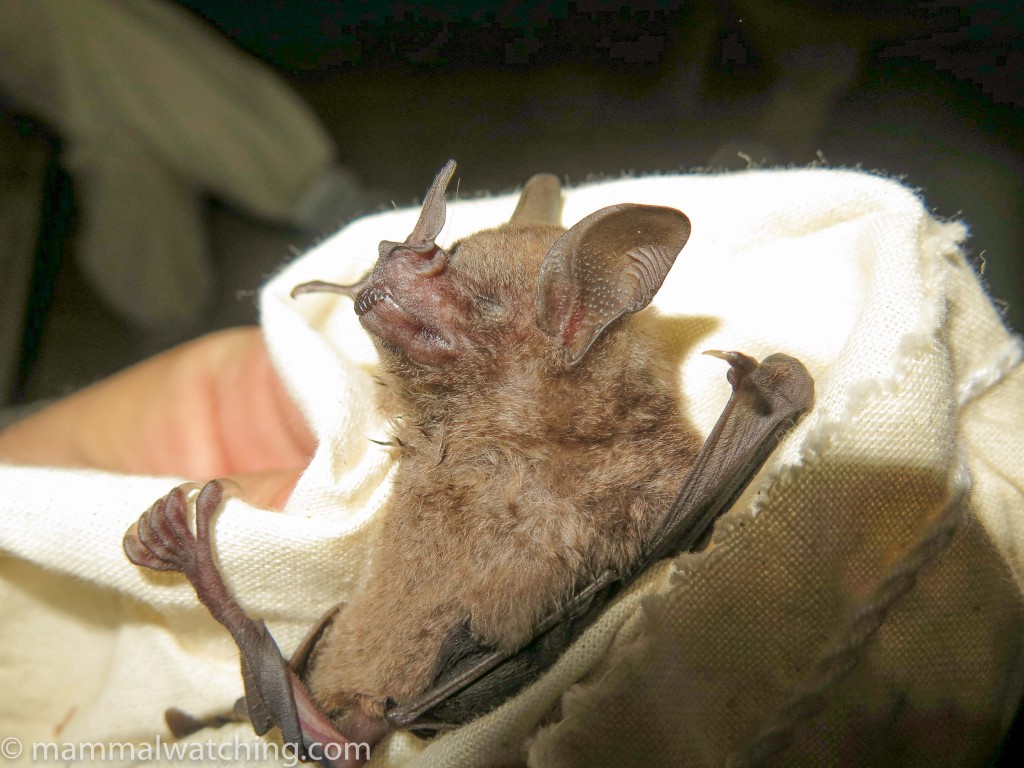
Silky Short-tailed Bat, Carollia brevicauda
Followed by a Tilda Yellow-shouldered Bat.
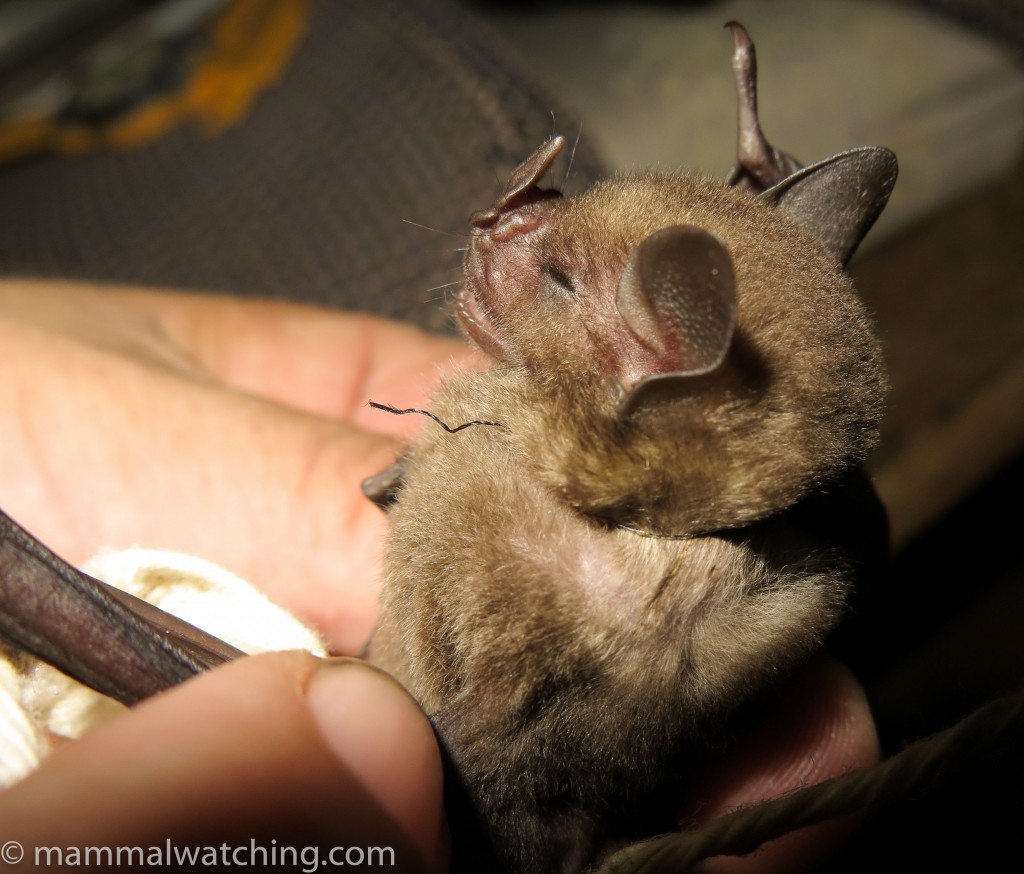
Tilda Yellow-shouldered Bat, Sturnira tildae
The last bat of the night was another Greater White-lined Bat.
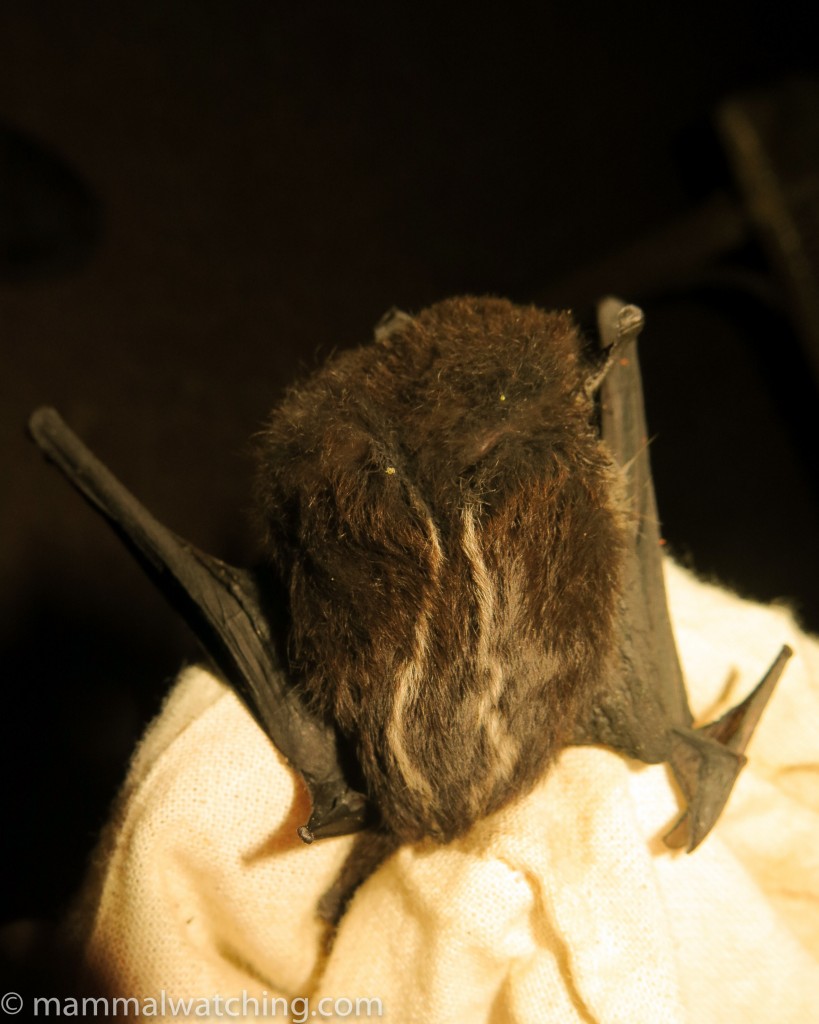
Greater White-lined Bat, Saccopteryx bilineata
Friday 27 March
We’d arranged a ride to Surama at 7am so I was up at dawn with John for a last try for the White-faced Sakis. They didn’t show.
The mouse opossum was now living in a plastic jar.
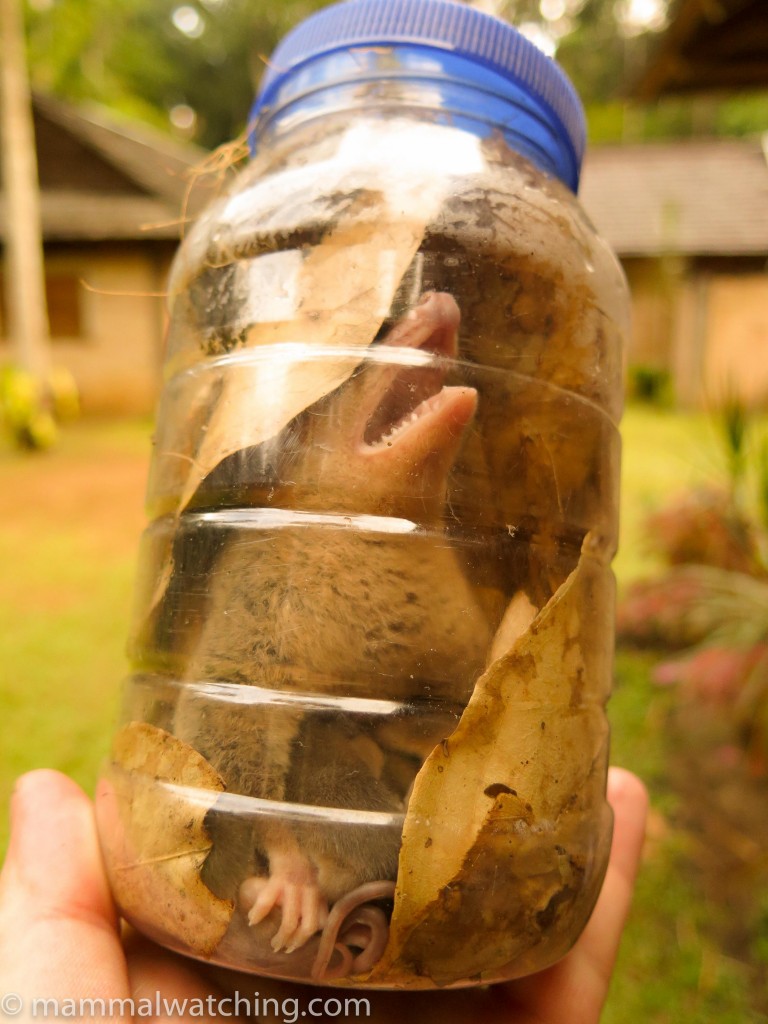
Long-furred Woolly Mouse-Opossum, Micoureus demerarae
After breakfast we waited for the vehicle. By 7.30 a.m. it hadn’t arrived, so Amber and I took a stroll up the entrance road on our own. Half way along some movement in a tree was a female White-faced Saki. Yes! The male soon appeared and hung out in the trees above the road for a good 10 minutes. I was too happy almost to care that I’d left my camera at the lodge. A brief rain shower had dampened the animals’ fur so it stuck to their heads, and the male looked like some sort of pale faced uakari.
I walked back to get my camera and, 15 minutes later, the monkeys were still there but in the process of leaving. I fired off a couple of shots which were extremely challenging in the light (my excuse for the terrible picture below).
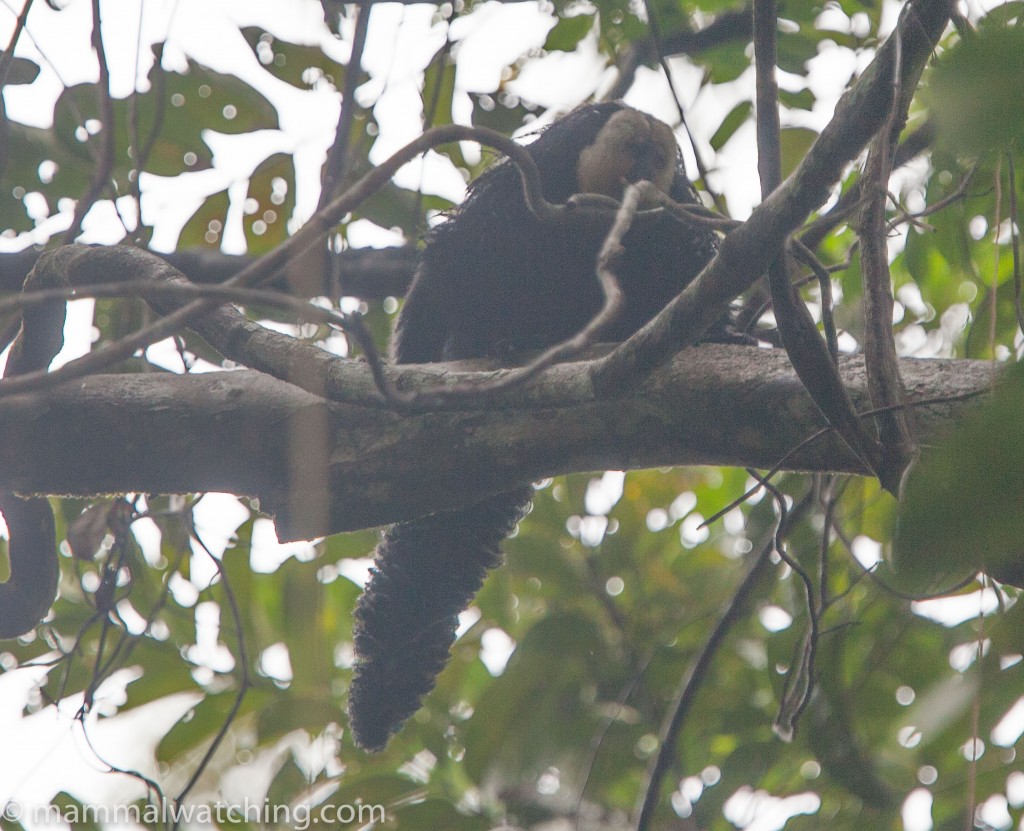
White-faced Saki, Pithecia pithecia
The Surama vehicle arrived at 8 a.m. and stoped en route at a well-known trail to a Cock of the Rock nesting sight. The bird was, indeed, spectacular – and spectacularly odd – but I was more interested in the bats roosting near the nest.
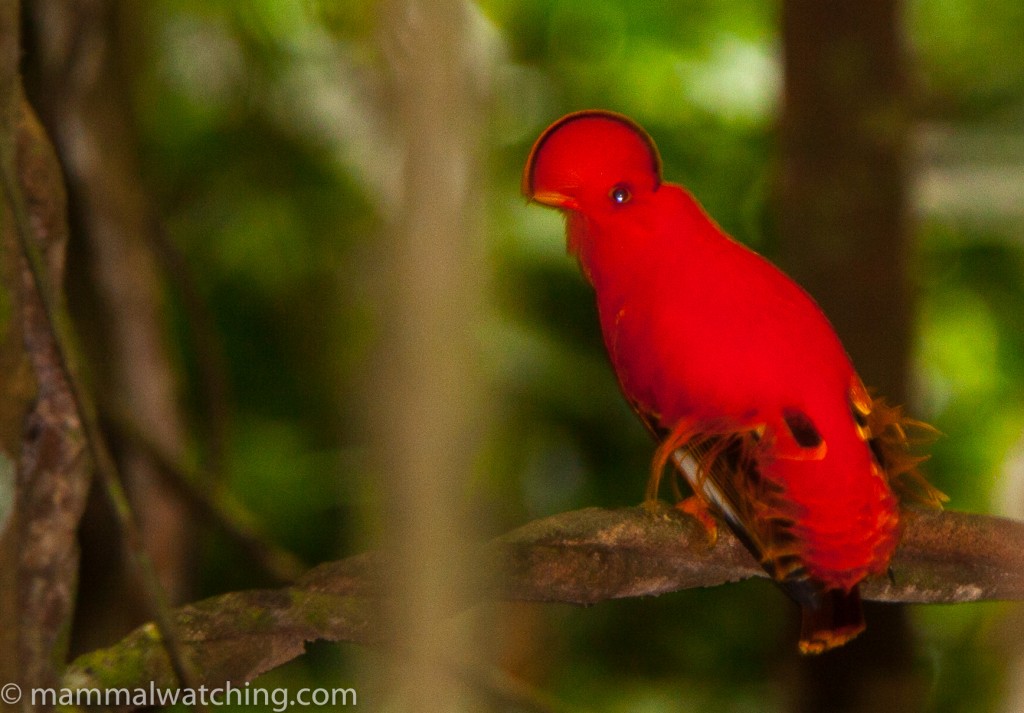
Cock of the Rock
A bunch of smaller phyllostomids were Common Big-eared Bats Micronycteris microtis (or M. megalotis which is now seen as conspecific).
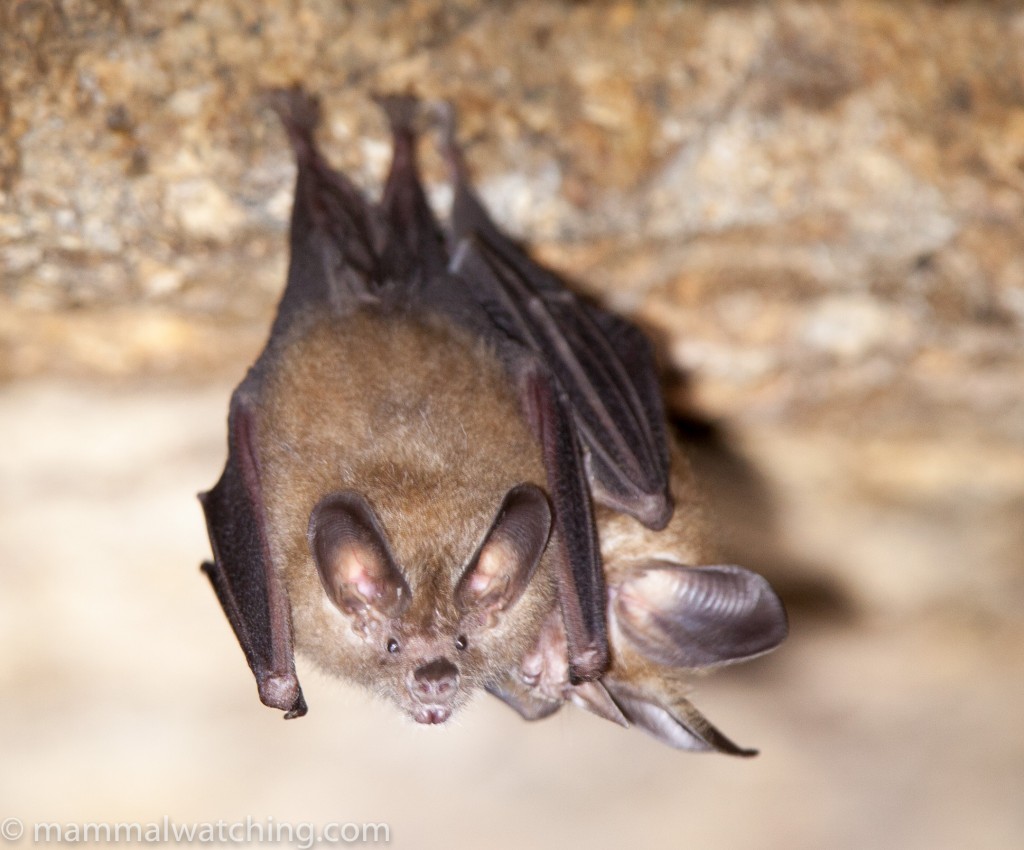
Common Big-eared Bat, Micronycteris microtis
The larger fruit bats were Flat-faced Fruit-eating Bats Artibeus planirostris.
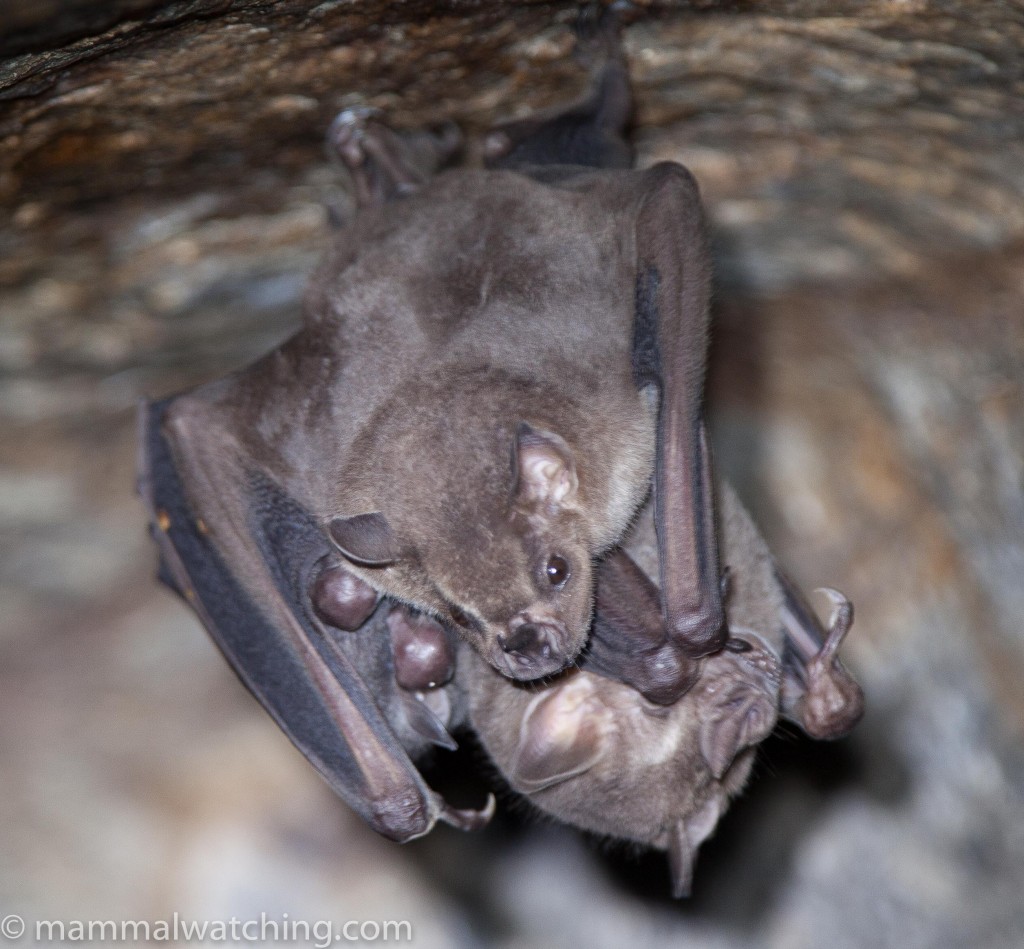
Flat-faced Fruit-eating Bat, Artibeus planirostris
While some emballonid bats perched on the rocks were Lesser Dog-like Bats Peropteryx macrotis.
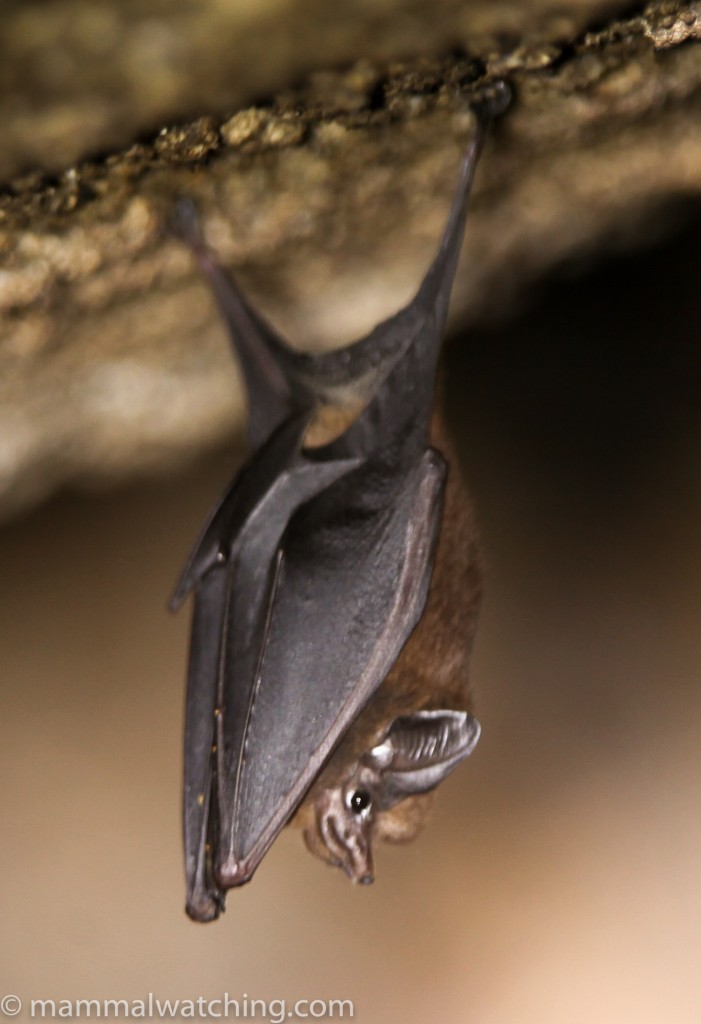
Lesser Dog-like Bat, Peropteryx macrotis
A thousand thanks to a very patient Fiona Reid for helping me ID all these!
It was another 30 minutes to Surama Lodge. It is perched on a little hill on the edge of the forest, and a very welcome breeze blew permanently through the lounge area.
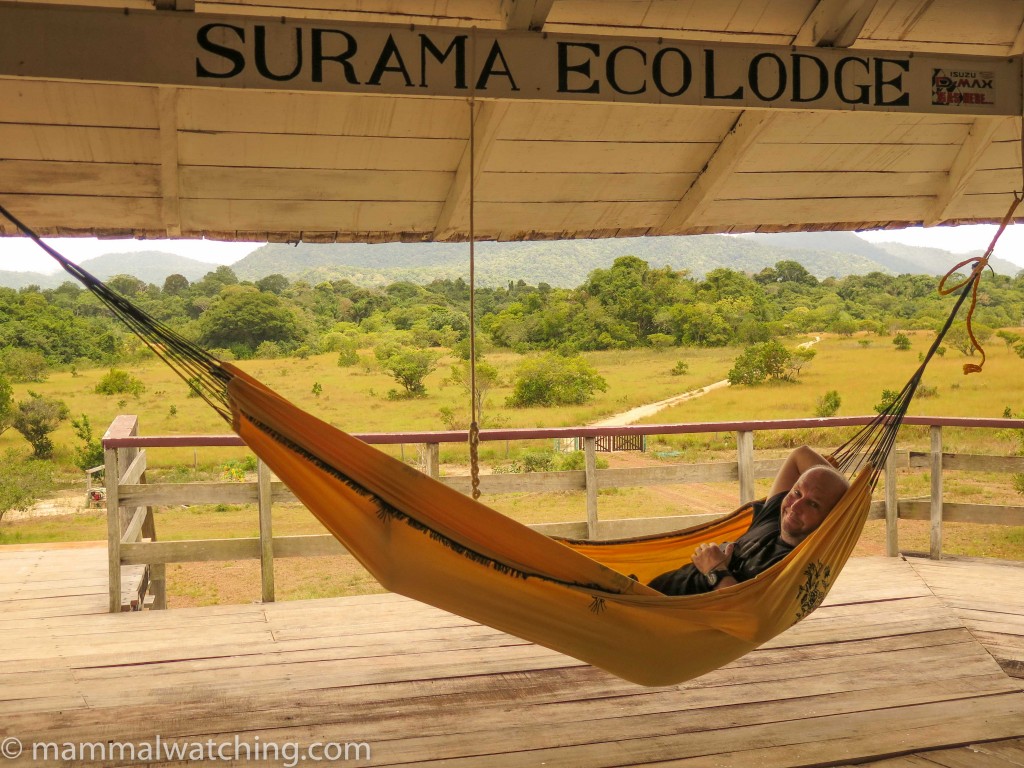
Surama siesta
Surama really is, as Sjef Ollers said, a community run project. Gary, our guide, was inspiring when he spoke about the way in which the community had moved from not even understanding the concept of tourism to running a business. When they begain in the late 1990s they had no idea that you could charge someone for food or lodging “we just used to give this to people.. that is what we always did”. As a result of their success they have become an inspiration for other Macushi settlements in Guyana and beyond.
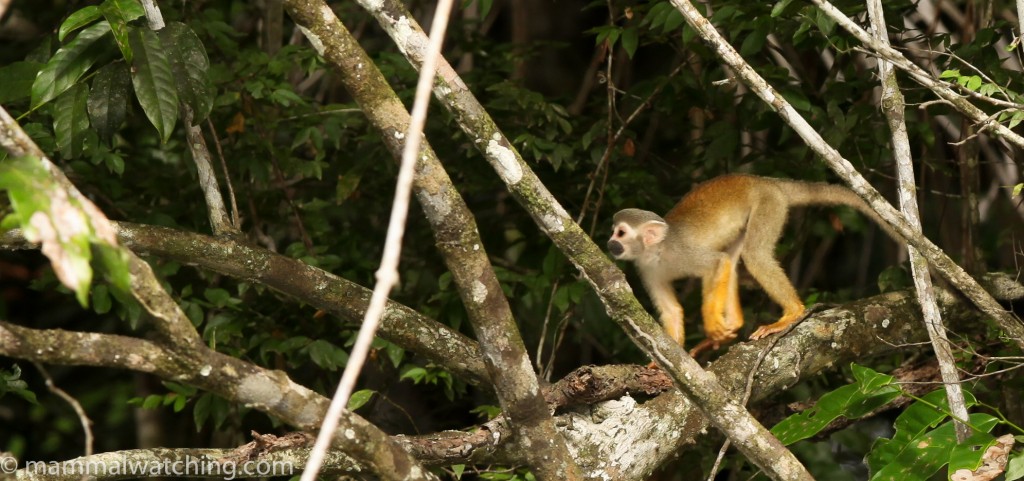
Guianan Squirrel Monkey, Saimiri sciureus
After a village tour, Gary took us in the late afternoon along a trail towards the river that starts at the lodge. He’d seen a Tayra along here two days earlier, and a Bush Dog a month before. The Bush Dog was quite a sighting – only the third time Gary had seen one in his 30 something years.
We weren’t so lucky but did see a group of Guyana Weeper – or Wedge-capped – Capuchins which are common in the area.
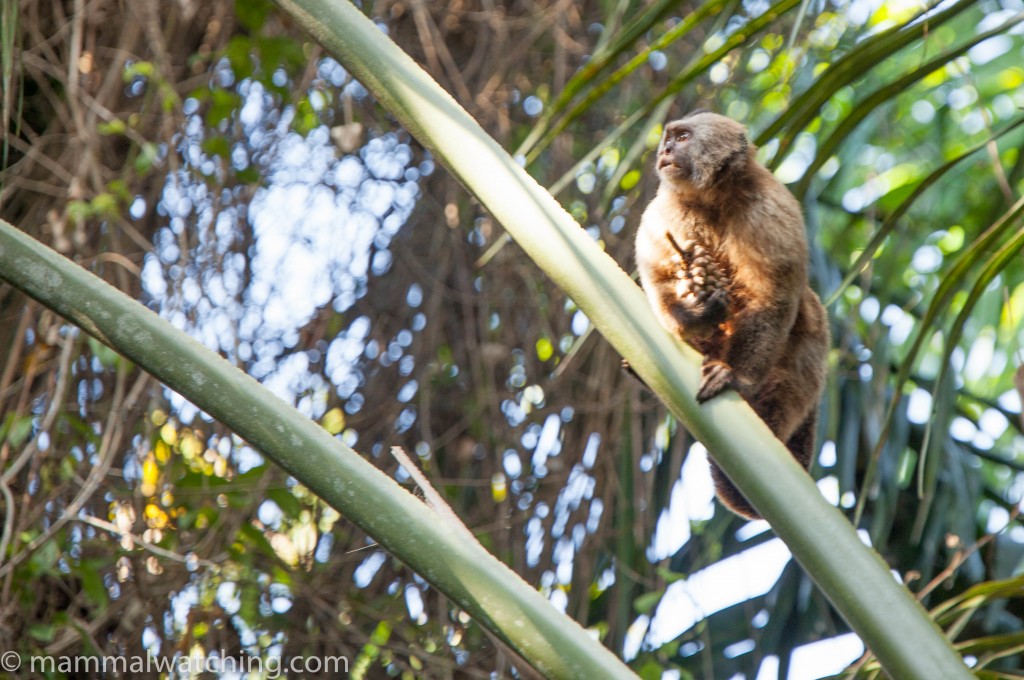
Guyana Weeper Capuchin, Cebus olivaceus
Back at the bar I asked Gary and Jackie if they remembered a character called Richard, immortalised in Sjef’s amusing trip report. They remembered him clearly. Cue much laughter.
That evening we went out for a spotlight drive along the road through the forest. Jaguars are spotted along the road quite often. But the road was – at 9 p.m. – still quite busy plus an extremely bright quarter moon limited our chances.
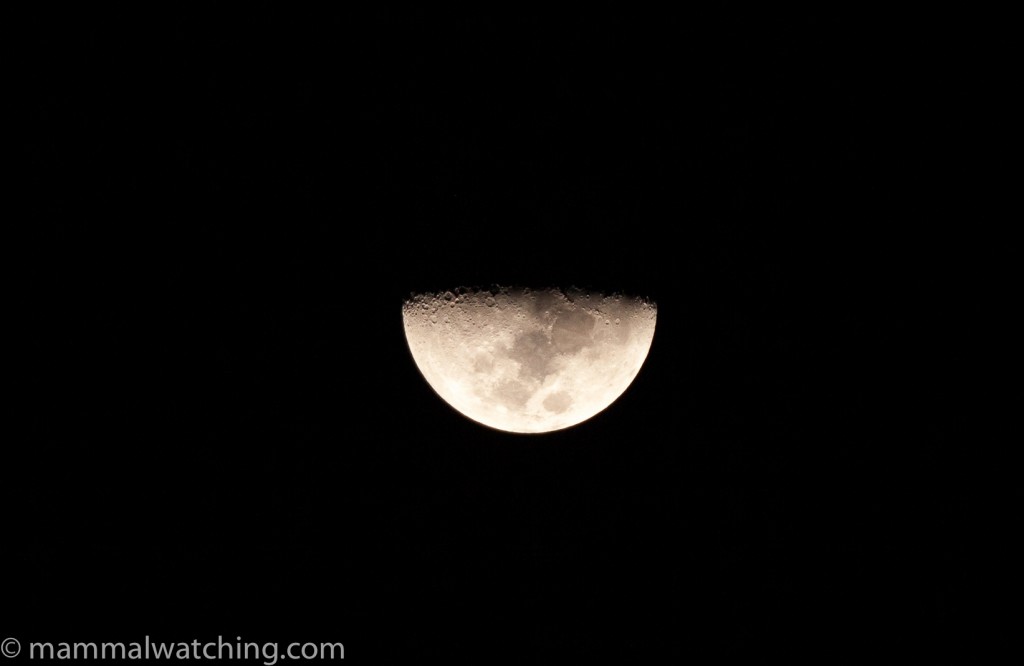
Saturday 28 March
Our last full day in Guyana. I hesitate to say I took it easy… but I was so pleased with my haul of mammals that I slowed down today.
Gary took us up Surama Mountain for a two hour humid hike to a nice viewpoint. We saw some howlers on the way up but nothing else.
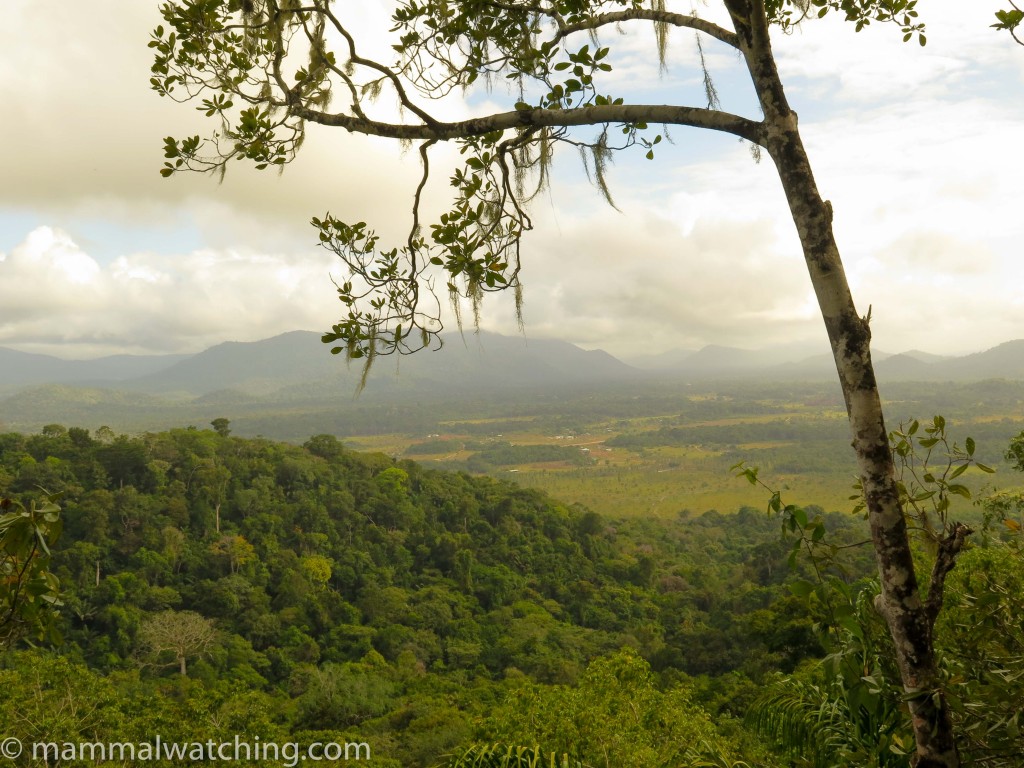
Surama viewpoint
Sadly Surama’s leader was burying his son today and the community was subdued. Gary insisted though on accompanying us for a paddle along the creek in the late afternoon. Lots of birds but no mammals.
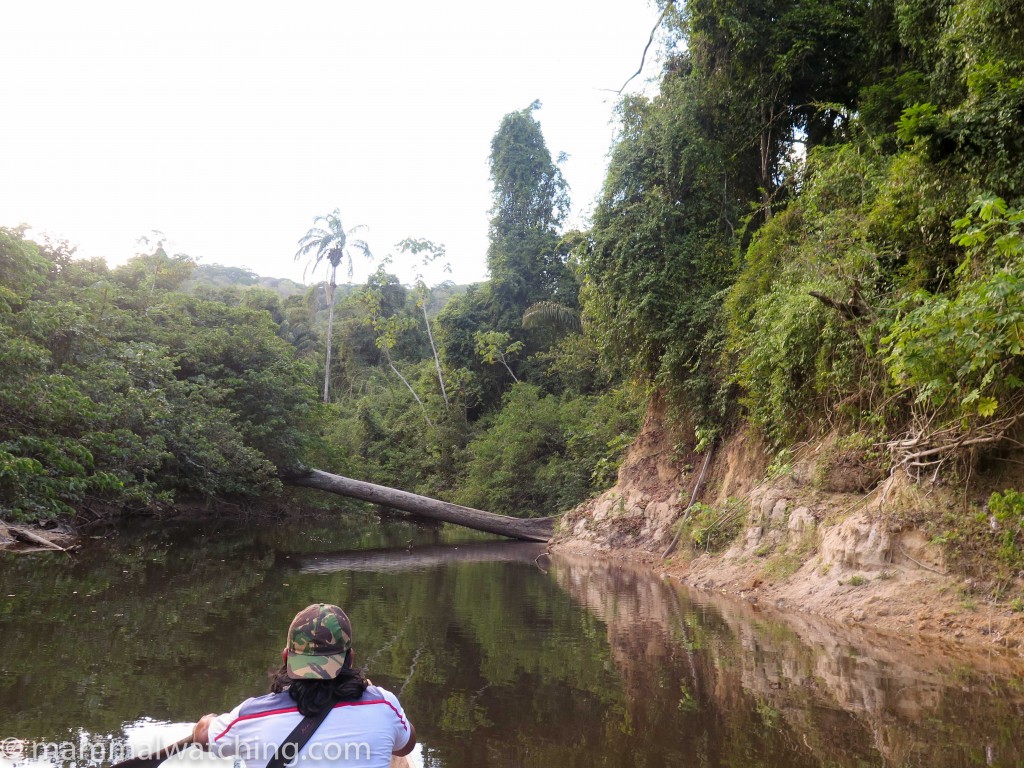
On the creek
Sunday 29 March
I got up at 4 a.m. for a last spotlight drive through Iwokrama forest. The only identified mammal was a Red-rumped Agouti, though some eyeshine in a bush – that we quickly lost – might have been more interesting.
After breakfast we were dropped back at Rockview Lodge where we waited for the flight to Georgetown and looked at the Artibeus planirostris roosting in the roof.
From there we had time for a lunch at the Cara Lodge hotel and then were taken straight to the airport for an evening flight, not even stopping to see the tame Manatees in the botanic gardens. Something else to see when I come back… and I surely will.
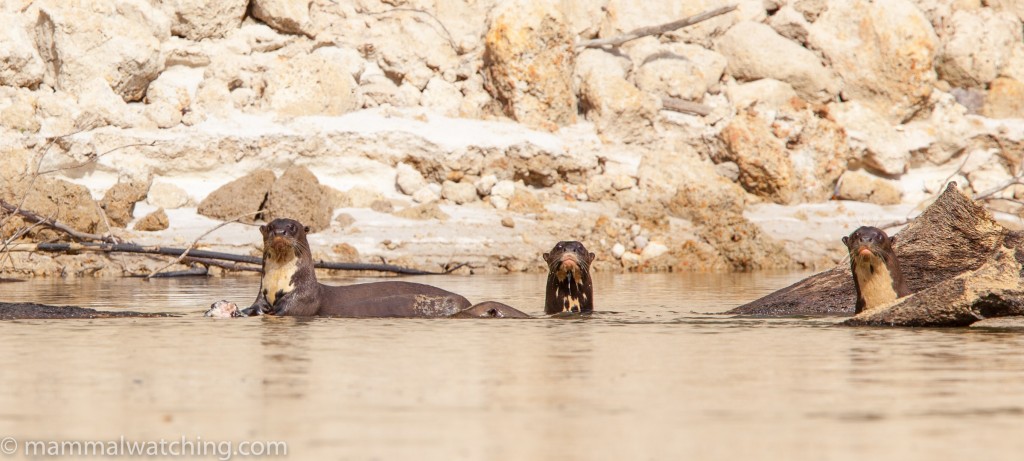
Giant Otters, Pteronura brasiliensis
Closing thoughts
It is quite amazing that so few visit this great country. I’d hoped I might see about 15 species in the week but ended up with 33, 15 of them new for me. Of course a bunch of bats helped but I was also delighted with the number of primates we saw and the quality of the views, as well as some of the other surprises.
Many thanks to our great guides Cain, John and Gary, from Rewa, Atta and Surama, respectively, all the friendly staff of every lodge, and to Fiona Reid for looking at countless bat pictures and correcting my usually wrong IDs when I got home.
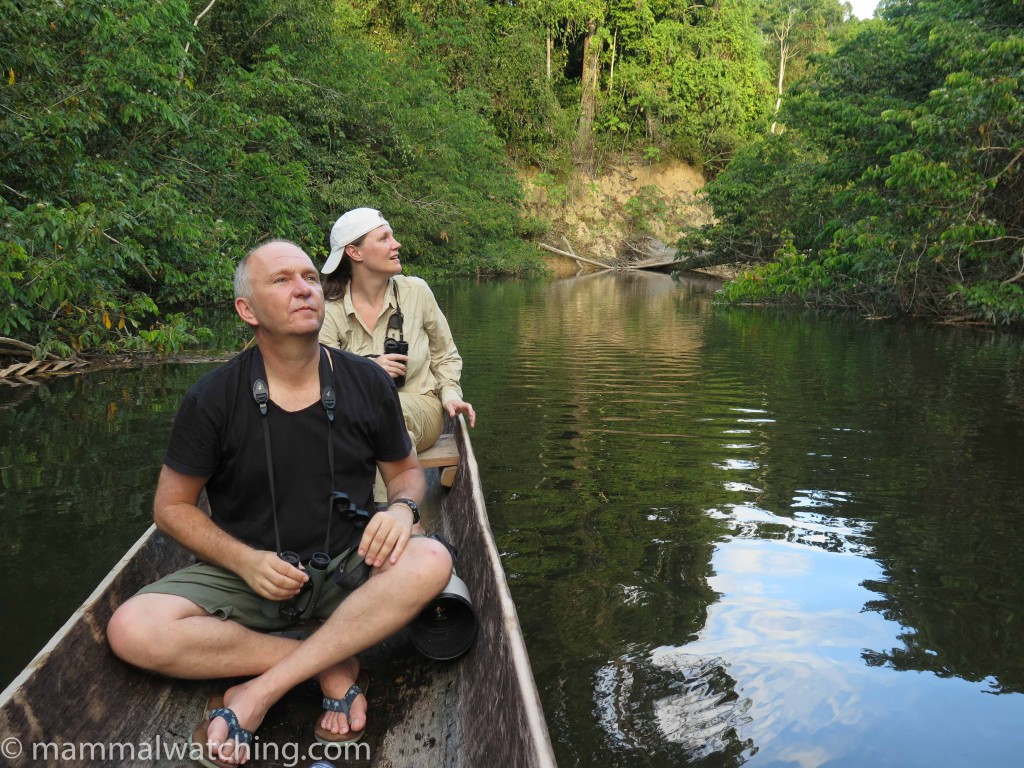
On the river at Surama
Trip List
F Long-furred Woolly Mouse-Opossum Micoureus demerarae
Southern Opossum Didelphis marsupialis
F Great Long-nosed Armadillo Dasypus kappleri
Guianan Squirrel Sciurus aestuans
Red-rumped Agouti Dasyprocta leporina
Paca Cuniculus paca
Giant Otter Pteronura brasiliensis
Kinkajou Potos flavus
Proboscis Bat Rhynchonycteris naso
Greater White-lined Bat Saccopteryx bilineata
Lesser Dog-like Bat Peropteryx macrotis
Lesser Fishing Bat Noctilio albiventris (uncertain)
Greater Fishing Bat Noctilio leporinus
F Tiny (Homez’s) Big-eared Bat Micronycteris (homezi) minuta
Common Big-eared Bat Micronycteris microtis
F Stripe-headed Round-eared Bat Tonatia maresi
F Lesser Spear-nosed Bat Phyllostomus elongatus
F Silky Short-tailed Bat Carollia brevicauda
Seba’s Short-tailed Bat Carollia perspicillata
F Dwarf Little Fruit Bat Rhinophylla pumilio
F Tilda Yellow-shouldered Bat Sturnira tildae
F Brock’s Yellow-eared Bat Vampyressa brocki
Hairy Big-eyed Bat Chiroderma villosum
Flat-faced Fruit-eating Bat Artibeus planirostris
F Gervais’ Fruit-eating Bat Artibeus cinereus
F Golden-handed Tamarin Saguinus midas
Common Squirrel Monkey Saimiri sciureus
Brown Tufted Capuchin Cebus apella
F Guyana Weepier Capuchin Cebus olivaceus
F Guianan Saki Pithecia pithecia
F Guianan Bearded Saki Chiropotes sagulatus
F Black Spider Monkey Ateles paniscus
F Guyanan Red Howler Monkey Alouatta macconnelli
33 SPECIES, 16 lifers (F).
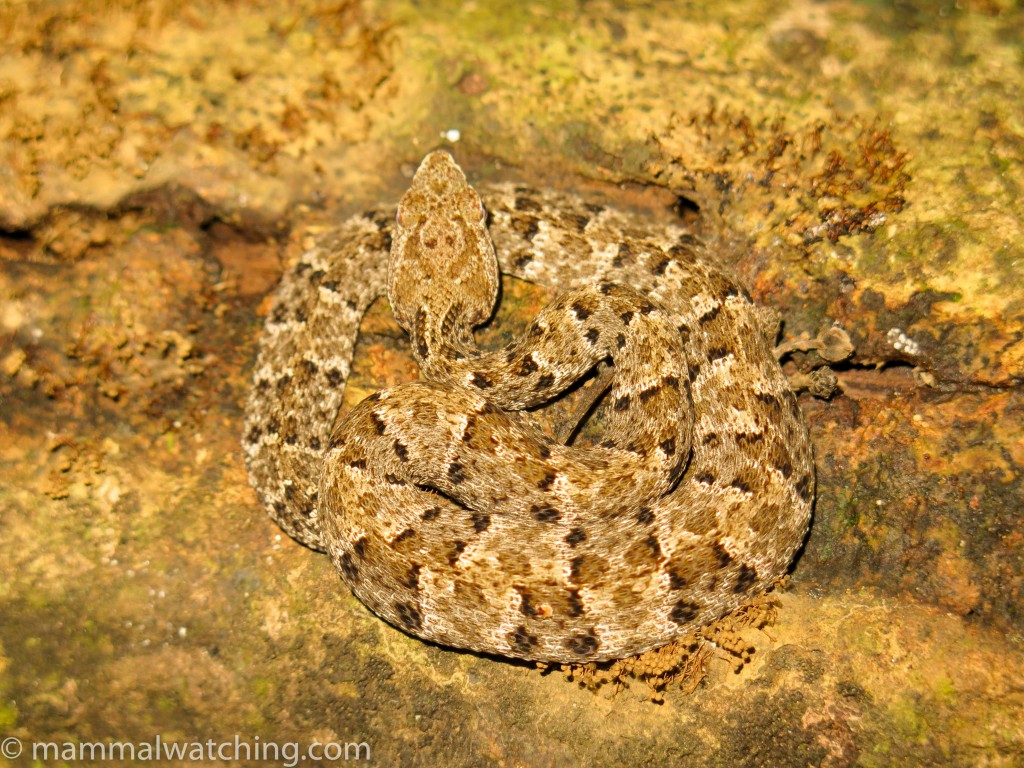
Fer de Lance, the only snake of the trip
Stuff I Missed
Of course there are many mammmals I didn’t see including Jaguar, Giant Anteater and Tapir but I made little effort to look for them. I did have an eye out for the two sloth species, but they seem quite difficult in most places other than perhaps Atta Lodge. However I was told me of a couple of islands in the Essequibo River near Georgetown where they are common. Somewhere to visit next time. Tayra are around too and they are pretty much guaranteed (at the moment at least) at Karanambo. And I got closer on this trip than I’d ever done to a Bush Dog… just a month away. Dare to dream.
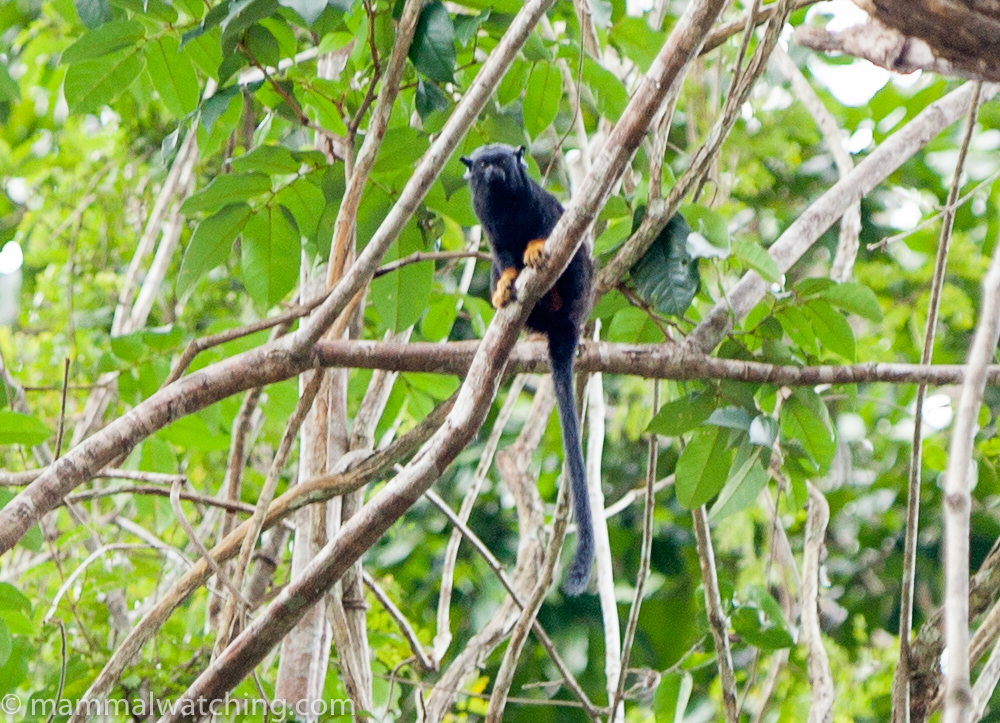
Golden-handed Tamarin, Saguinus midas, Rewa
Community Reports
Guyana, 2021: Cheryl Antonucci, 16 days & 21 species including Red-handed Tamarin, Red-faced Spider Monkey and Red-rumped Agouti.
Guyana, 2014: Ian Lloyd’s report of a trip with mammals including Tayra, Giant Otter, Giant Anteater and many primates.
Guyana and Suriname, 2011: Sjef Ollers, 3 weeks & 21 or so species including Golden-handed Tamarin, Bearded and White-faced Sakis and a Jaguar.
Also See
Please email me if you have tips for mammal watching in this area.
Resources
A thorough list of potential Guyanan mammals from the Smithsonian is here and another – for Iwokrama Forest – is here.


Leave a Reply
You must be logged in to post a comment.